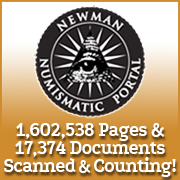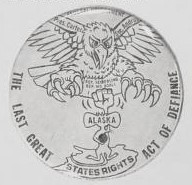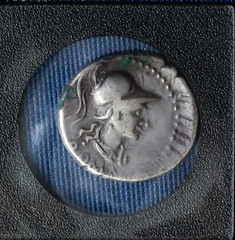
About UsThe Numismatic Bibliomania Society is a non-profit organization devoted to the study and enjoyment of numismatic literature. For more information please see our web site at coinbooks.org SubscriptionsThose wishing to become new E-Sylum subscribers (or wishing to Unsubscribe) can go to the following web page link MembershipThere is a membership application available on the web site Membership Application To join, print the application and return it with your check to the address printed on the application. Print/Digital membership is $40 to addresses in the U.S., and $60 elsewhere. A digital-only membership is available for $25. For those without web access, write to: Terry White, Treasurer AsylumFor Asylum mailing address changes and other membership questions, contact Terry at this email address: terrywhite5475@yahoo.com SubmissionsTo submit items for publication in The E-Sylum, just Reply to this message, or write to the Editor at this address: whomren@gmail.com BUY THE BOOK BEFORE THE COINSale Calendar |
- WAYNE'S WORDS: THE E-SYLUM JANUARY 28, 2018
- NEW BOOK: FRANKLIN, KENNEDY HALF DOLLARS, 3RD ED.
- ED ROCHETTE (1927-2018)
- ROBERT THOMPSON (1944-2017)
- NEWMAN PORTAL ADDS ALASKAN ZNACHKI BULLETIN
- NEWMAN PORTAL SEARCH: GEORGE H. EARLE
- 2018 ANS GALA DINNER
- ANS LECTURE: MARK TOMASKO ON BANKNOTE ENGRAVING
- NOTES FROM E-SYLUM READERS: JANUARY 28, 2018
- THE MINT'S SO-CALLED FIRST SCREW PRESS
- HEIDI WASTWEET’S MEDALLIC ART
- VOCABULARY TERM: DIE LIFE
- WALTER FREEMAN WEBB (1869-1957)
- IN MEMORIAM: THEODORE V. BUTTREY, JR.
- KLEEBERG ON TED BUTTREY VS. JOHN FORD
- VAN RYZIN ON SELMA BURKE AND JOHN SINNOCK
- INTERVIEW WITH COIN DESIGNER JOEL ISKOWITZ
- JOSHUA MCMORROW-HERNANDEZ EXPLORES EXONUMIA
- NORTH CAROLINA WRECK YIELDS GOLD COINS
- MORE ON RAYMOND'S EASY DISPLAY SYSTEM
- QUERY: WAS THIS GASPARRO’S LAST MODEL?
- QUERY: S.B. CHILDS TOKEN DESIGN SOURCE SOUGHT
- NUMISMATIC NUGGETS: JANUARY 28, 2018
- YEAR OF FOUR EMPERORS DENARIUS RECOVERED
- MORE ON ANCIENT CLOTHING STYLES
- CNG’S TRITON XXI POSTSALE REPORT
- 7TH CENTURY GANGA DYNASTY COINS DECIPHERED
- THE ART OF OBSOLETE SEPTA TOKENS
- A MEDAL OF MICHELANGELO
- SOVIET ERA RUSSIAN ZNACHKI
- PINK GOLD BREAST CANCER AWARENESS $5 COIN
- DENNIS TUCKER ON THE NEW U.S. MINT MEDAL PROGRAMS
- SCARINCI ON THE U.S. MINT'S NEW MEDAL PROGRAM
- BANKNOTE DESIGN AT NORGES BANK
- RENOVATION UNCOVERS DECADES-OLD COIN COLLECTION
- TIME-LAPSE VIDEO: SHREDDED BANKNOTE RECONSTRUCTION
- HACKER JACKPOTS: ATMS SPIT OUT THEIR BANKNOTES
- FEATURED WEB SITE: OCALA COIN CLUB
Click here to access the complete archive
To comment or submit articles, reply to whomren@gmail.com
Content presented in The E-Sylum is not necessarily researched or independently fact-checked, and views expressed do not necessarily represent those of the Numismatic Bibliomania Society.
WAYNE'S WORDS: THE E-SYLUM JANUARY 28, 2018
 New subscribers this week include: Mandar Bhagwat, courtesy of Pablo Hoffman; Clay Barrineau, A.J. Gatlin, and Yw Zhang. Welcome aboard! We now have 3,413 subscribers.
New subscribers this week include: Mandar Bhagwat, courtesy of Pablo Hoffman; Clay Barrineau, A.J. Gatlin, and Yw Zhang. Welcome aboard! We now have 3,413 subscribers.
Thank you for reading The E-Sylum. If you enjoy it, please send me the email addresses of friends you think may enjoy it as well and I'll send them a subscription with your compliments. Contact me at whomren@gmail.com anytime regarding your subscription, or questions, comments or suggestions about our content.
This week we open with one new book, two obituaries, and updates from the ANS and Newman Numismatic Portal. Other topics this week include Heidi Wastweet, Walter Webb, Ted Buttrey, John Ford, Selma Burke, John Sinnock, Joel Iskowitz, Frank Gasparro, ancient clothing styles, Russian znachki, and ATM jackpotting.
To learn more about Kennedy half dollars, Ed Rochette, Robert Thompson, Jonathan Rosen, vignette artwork, The Great Debate, Mardi Gras Doubloons, the Year of Four Emperors, wearable SEPTA tokens, and pink gold, read on. Have a great week, everyone!
Wayne Homren
Editor, The E-Sylum
NEW BOOK: FRANKLIN, KENNEDY HALF DOLLARS, 3RD ED.
Groundbreaking Research Leads to New Rick Tomaska Book on Franklin and Kennedy Half Dollars
by Dennis Tucker
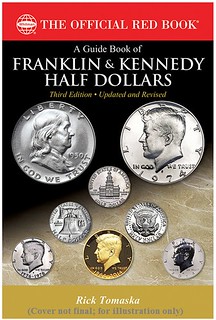 I first met Rick Tomaska (virtually, through email and phone conversations) in the early weeks of 2005, not long after I came aboard as publisher at Whitman Publishing. Editorial work was
under way on the 59th edition of the Guide Book of United States Coins (the hobby’s popular “Red Book”), and Rick shared his knowledge of Special Mint Sets, cameo designations, and coin
pricing. He had recently contributed to David W. Lange’s Guide Book of Modern United States Proof Coin Sets. We kept in touch over the years on various numismatic book projects. Then in 2008
we started talking about Franklin half dollars, and the growing collector interest in these coins, especially in high grades. Rick had already written two editions of his Complete Guide to
Franklin Half Dollars, published by DLRC Press. That May, after our conversations turned toward the potential of Rick writing a book for Whitman, I envisioned him in our Bowers Series lineup. In
this format his work would be published in full color in our standard six-by-nine–inch trim.
I first met Rick Tomaska (virtually, through email and phone conversations) in the early weeks of 2005, not long after I came aboard as publisher at Whitman Publishing. Editorial work was
under way on the 59th edition of the Guide Book of United States Coins (the hobby’s popular “Red Book”), and Rick shared his knowledge of Special Mint Sets, cameo designations, and coin
pricing. He had recently contributed to David W. Lange’s Guide Book of Modern United States Proof Coin Sets. We kept in touch over the years on various numismatic book projects. Then in 2008
we started talking about Franklin half dollars, and the growing collector interest in these coins, especially in high grades. Rick had already written two editions of his Complete Guide to
Franklin Half Dollars, published by DLRC Press. That May, after our conversations turned toward the potential of Rick writing a book for Whitman, I envisioned him in our Bowers Series lineup. In
this format his work would be published in full color in our standard six-by-nine–inch trim.
I talked with Q. David Bowers (Whitman’s numismatic director) and with our sales team, studied the market and collector demand, and looked at activity in auctions and set registries. Would a book dedicated solely to Franklin half dollars be big enough for our publishing needs? Such a book would have been our first Bowers Series volume devoted to a single relatively short modern coinage series. (In 2007 we had covered Jefferson nickels, but we combined them with Buffalo nickels into a 288-page volume.) I began to wonder if we might broaden the scope of Rick’s book by including Kennedy half dollars. To gauge the strength of this idea I conducted an informal poll of 146 novice, intermediate, and advanced coin collectors. About one-third of them actively collected Kennedy half dollars—that included hobbyists who were constantly upgrading their sets, those who were filling holes in an album or folder, and enthusiasts who sought every Fivaz-Stanton die variety. Another 13 percent identified themselves as casual collectors of the coins (“Yes, I collect them, but not actively”). Another one-third said they owned some Kennedy half dollars but considered them more of an accumulation than a carefully assembled collection. And about one-quarter of the hobbyists I polled didn’t collect Kennedy half dollars at all.
This information painted a picture of a coin with many passionate fans, a robust presence in the hobby community, and the potential to continue growing in popularity. I asked Rick what he thought of covering Kennedy half dollars in his book. “An interesting proposition,” he opined. “The two series are closely tied together and they complement each other.” Dave Bowers agreed. “I think this is a dandy idea,” he emailed me in June. (Yes, conversations that started in early May were still ongoing in June! Decision-making in the publishing world can take a while.) “These are very popular,” Dave said, “and Rick Tomaska is a tried, tested, and true name.”
We moved forward. Rick tackled the million moving parts involved in putting together a book manuscript—researching, writing, photographing coins, gathering data—and the Guide Book of Franklin and Kennedy Half Dollars debuted in December of 2010 as volume 15 in the Bowers Series. It was the first book devoted substantially to the Kennedy half dollar, while also showcasing the author’s extensive knowledge of the Franklin series. It was immediately popular in the hobby, and our inventory sold out by the end of 2011. Rick updated the book in a second edition that came out in early 2012. It went through several printings over the next five years.
Since then much has happened in the world of Franklin and Kennedy half dollars. The latter coins were highlighted in William Rice’s acclaimed The Kennedy World in Medallic Art, a study of John F. Kennedy and his family in coins, tokens, medals, and other collectibles. The United States Mint issued, to great fanfare and excitement, a special gold Kennedy half dollar and several silver versions that celebrated the coin’s 50th anniversary. This brought national mainstream news coverage to the hobby. Meanwhile, collector interest has climbed for both series. The number of registry-set collections of Franklin half dollars has more than doubled since the first edition of this book was published. Auction records have continued to be broken, and numismatic research has been ongoing.
The newly expanded third edition of the Guide Book of Franklin and Kennedy Half Dollars will debut in a few weeks. Rick Tomaska has updated the market commentary, the pricing, auction records, and other details about each coin. He has increased the catalog to include more recent coins, added a section on Proof Liberty Walking half dollars (precursors to the Proofs of the Franklin series), shared his definition and analysis of exceptional cameo contrast, gathered auction and private-sale records, and included new photographs. Longtime collectors will appreciate the new information in this volume, while beginning collectors will benefit from an immersion in its two very popular and historically significant coin series.
As a publisher and as a numismatist, I’m pleased that Rick’s book has accomplished so much, resonated with so many collectors new and old, and taken a significant position in the body of important numismatic literature.
A Guide Book of Franklin and Kennedy Half Dollars, 3rd edition By Rick Tomaska; foreword by Q. David Bowers
ISBN 0794845290
Softcover, 6 x 9 inches, full color
320 pages
Retail $19.95 U.S.
URL: https://www.whitman.com/store/Inventory/Detail/A-Guide-Book-of-Franklin-and-Kennedy-Half-Dollars-3rd-Edition+0794845290
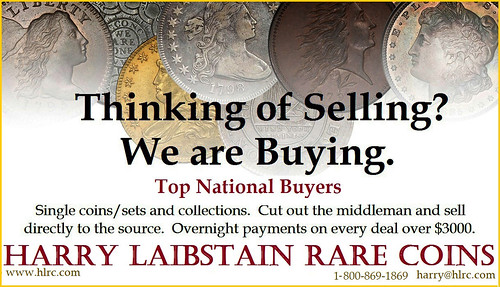
ED ROCHETTE (1927-2018)
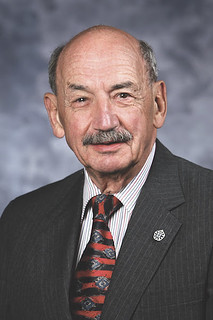 Former ANA President and Executive Director Edward C. Rochette, 90, died on January 18 in Colorado Springs, Colorado, where he lived most of his life. He was born on February 17, 1927, in
Worcester, Massachusetts, to Edward Rochette, a physician, and Lilia A. (Viau) Rochette, both of whom died before Ed Jr. reached adulthood.
Former ANA President and Executive Director Edward C. Rochette, 90, died on January 18 in Colorado Springs, Colorado, where he lived most of his life. He was born on February 17, 1927, in
Worcester, Massachusetts, to Edward Rochette, a physician, and Lilia A. (Viau) Rochette, both of whom died before Ed Jr. reached adulthood.
Friends and family remember Rochette’s sparkling wit, creative spirit, astute mind, and strong ethical compass, which he relied upon to guide his life and family. He developed his love for numismatics as a youngster, when he regularly searched the cash drawer at his grandfather's diner for collectible coins. He served as an electrician in the U.S. Navy during World War II, and attended Clark University in Worcester and Washington University in St. Louis, Missouri.
Rochette began his professional numismatic career as a cartoonist and editor for Numismatic News, printed in lola, Wisconsin, by Krause Publications. Later, he served the company as executive editor. In 1966 Rochette left Iola to become editor of The Numismatist, the Association’s official journal. As editor, Ed had a front-row seat for the construction of the new ANA headquarters, which began on the Colorado College campus about the same time he (and later his family) moved to town. The March 1967 issue of The Numismatist was the first to roll off the presses under his leadership.
He sat in the editor’s chair until 1972, when he was tapped to serve as ANA executive vice president. The Association prospered in its new home, but within 13 years it began to experience growing pains. Rochette was at the helm when a drive was launched in 1980 to finance a second-story addition that would expand the museum, library and staff offices. He shepherded the construction, keeping an eye on the progress and making sure all went according to plan. On June 10, 1982, he was on hand to welcome guests and dignitaries to the official dedication.
Rochette retired as executive vice president in 1986, and in 1987 was elected to the ANA Board of Governors, going on to serve as vice president in 1989-91 and president in 1991-93. In the years that followed, ANA museum and library visitation increased markedly, and the facility was sorely in need of a facelift. In 1998, Rochette was called out of retirement to serve as ANA executive director, and in 2000 he spearheaded and oversaw a second headquarters renovation.
Rochette stepped down as executive director in July 2003. Thanks to a $500,000 contribution from an anonymous donor and his longtime friend, mentor and employer Chester Krause, the ANA Money Museum was renamed in his honor in 2005. Two years later, Rochette ran successfully for the ANA Board, serving a term as governor .
Rochette devoted his long career to sharing the many fascinating stories behind coins and medals. In 2006 he told COINage magazine, "I've never gone out and tried to corner a market or buy something because it was rare. I'd buy it because I could write a story about it."
Rochette was a prolific and popular author, penning the monthly “Other Side of the Coin” column for The Numismatist for two decades. He wrote a weekly coin column that was nationally syndicated by the Los Angeles Times, and contributed a monthly column to COINage. He published books on three favorite topics: Medallic Portraits of John F. Kennedy (1966), Making Money: Rogues and Rascals Who Made Their Own (1986) and The Romance of Coin Collecting (1991).
In the late 1960s, Rochette collaborated with Lt. Col. Adna G. Wilde Jr., then ANA executive director, to introduce the week-long ANA Summer Seminar in Colorado Springs. He also was instrumental in developing a numismatic exhibit for the International Olympic Committee's museum in Lausanne, Switzerland, and served as a numismatic consultant to the U.S. Olympic Committee and the U.S. Air Force Academy.
In 1987 he was general chairman of the 50th Anniversary Congress and Exhibition of the Fédération Internationale de la Médaille (FIDEM), a global organization of medallic artists. The event was hosted by the American Numismatic Association, marking the first time FIDEM had convened in the United States.
Collaborative and congenial, Rochette made friends easily and cultivated relationships that benefited the ANA. In 1977, he secured a bequest from ANA life member Kenneth Keith that remains a key financial asset, securing the Association’s future.
Rochette has received many ANA accolades, including the Medal of Merit (1972), Farran Zerbe Memorial Award for Distinguished Service (1987), Glenn Smedley Memorial Award (1993), Lifetime Achievement Award (1999), Burnett Anderson Memorial Award for Excellence in Numismatic Writing (2003, presented jointly by the ANA, American Numismatic Society and the Numismatic Literary Guild), and Numismatist of the Year (2003). He was the second recipient of the Numismatic Literary Guild’s prestigious Clemy Award (1969), and was named a Numismatic Ambassador by Numismatic News (1986). In 2000, he was inducted into the Numismatic Hall of Fame at the ANA’s Colorado Springs headquarters.
Says author and ANA Past President Q. David Bowers, “Next to the Association’s founder George F. Heath, no one has done more for the ANA than Ed Rochette.
Rochette is survived by his wife of 40 years, Mary Ann; three sons (Edward, Paul and Philip) by his first wife, Faye (who died in 1977); four stepchildren (Joseph, Michael, Paul and Susan); 14 grandchildren; and 7 great-grandchildren. Donations in his memory can be made to New Century Hospice, 6270 Lehman Dr., Suite 150, Colorado Springs, CO 80918.
Howard Daniel
Howard Daniel writes:
Another excellent numismatist gone!
Numismatic News
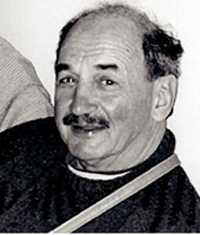 Ed Rochette’s contributions to the welfare of the American Numismatic Association and our hobby community, in my opinion, were seminal and probably incalculable in importance over the more
than half century of his active involvement.
Ed Rochette’s contributions to the welfare of the American Numismatic Association and our hobby community, in my opinion, were seminal and probably incalculable in importance over the more
than half century of his active involvement.
Their range stretched from the “Numismapest” cartoon series he crafted and inaugurated in the July 5, 1954 edition of Numismatic News, through and beyond his return to serve on the ANA board (2007-2009) in its most recent time of crisis.
Very creative as a cartoonist and writer, Ed was truly in his element when he discovered remote ties to numismatics. Much as a novelist, he could tie the known facts into a neat informative, entertaining and enjoyable package. Likewise, as he showed in his pioneering 1966 Medallic Portraits of John F. Kennedy reference, he was equally adept at digging out subject materials and the associated facts.
At the ANA Ed Rochette, again, in my opinion, contributed greater dedication to the organization, and quite possibly to the welfare of our hobby community, than any other person in its history, perhaps inclusive of founder Dr. George F. Heath. He variously over time pulled the ANA up by its bootstraps as editor, executive director, board member and president. Those accomplishments are legion.
To read the complete article, see:
Ed Rochette gave selfless service (http://www.numismaticnews.net/article/ed-rochette-gave-selfless-service
Dave Harper
News arrived yesterday of the death of Edward C. Rochette on Jan. 18 at the age of 90.
I will miss him, as to know him was to realize he was a force of nature.
Some old friends in Iola, Wis., remembered him warmly.
He had shocked the community by painting his house a New England red. It is gorgeous. It is still that color.
But in Iola in the early 1960s, it had just not been done before, and it was called “barn red.” Tut tut tut. And to what had been the house of a judge no less.
But Ed was always his own man.
To read the complete article, see:
Unforgettable Ed Rochette has died (http://www.numismaticnews.net/buzz/unforgettable-ed-rochette-died)
Leon Worden
After the war he finished high school, attended Washington University in St. Louis, "got really interested in coins" and joined the Missouri Numismatic Society. He landed his first "publishing" job, if you can call it that, with a company in St. Louis that manufactured Christmas and other wrapping paper.
"I was in the composing room. I did everything from typesetting to making the printing plates. I also worked in the art department a little bit. That’s where I started cartooning."
It was his cartooning that first got the attention of Krause, who had just started publishing the weekly Numismatic News. It was "primarily an advertising sheet with a few bits of club news" with "all advertising on the front page," Rochette said. "I wrote Chet and said, ‘You ought to dress up the front page with a cartoon." And so he said, ‘Send one.’ So that’s how I got started with Chet."
Called "Numispest," the cartoon "was about a coin collector," Rochette said. "I think the very first one was a guy standing there cleaning his coins, and the acid was dripping down, eating his pant leg, and somebody was saying, ‘I think it’s a little too strong for coins.’"
Dick Johnson
Dick Johnson writes:
Among other things, Edward Rochette will be remembered for his book on John F. Kennedy medals. I found his book useful for cataloging for years. It remained the standard work on the subject for fifty years. It is unfortunate he did not keep this popular collecting specialty book up-to-date. In 2014 the field had grown, when Bill Rice published his catalog of Kennedy items, there were more than 8,500 varieties.
Ed liked to travel. Once he became executive director of ANA this offered him the opportunity to travel the world. He represented American numismatics everywhere he went. He enjoyed the political activities in the field.
We remained friends for a lifetime, including the time when he was editor of Numismatic News, and I was editor of Coin World, friendly competitors. So here’s my tribute to a friend. Rest in Peace.
CoinWeek
If you are now or ever have been a member of the American Numismatic Association (ANA) in the last 50 years, it’s because a man named Ed Rochette devoted a large portion of his professional life to
its success. His decades of work for the organization earned him the nickname “Mr. ANA”.
During his tenure on the Board, Rochette oversaw the expansion of the ANA Money Museum and Numismatic Library in Colorado Springs, the establishment of the Harry W. Bass, Jr. Gallery of United States Gold Coins, and a revamping of The Numismatist. He is also responsible for launching the successful ANA Summer Seminars, a numismatic experience for which a generation (and then some) of budding numismatists are forever grateful.
To read the complete article, see:
In Memoriam – “Mr. ANA”: Edward C. Rochette, 1927-2018
(https://coinweek.com/people-in-the-news/memoriam-mr-ana-edward-c-rochette-1927-2018/)
Pete Smith
Pete Smith of Minneapolis, MN writes:
Ed’s cognitive skills were already somewhat diminished and he could no longer drive to these meetings. Other members were happy to provide a ride to the monthly dinner.
I don’t recall having much of a conversation with Ed. At one point he stared at his water glass and commented that he saw the face of a cat in the glass. I moved to look from his point of view. The reflection of overhead lights on the side of the glass did indeed look like the face of a cat.
Although he may have missed some of the conversation at the rest of the table, Ed was able to see something in the glass that the rest of us would have missed.
It is sad to see such a bright light in numismatics fade away in his declining years. That light has now gone out. Those whose path was illuminated by Ed in the past should appreciate his memory.

ROBERT THOMPSON (1944-2017)
Robert H. Thompson, FRNS, MCLIP, FSA (1944-2017), was a British numismatist, with a special interest in tokens and paranumismatica.
Thompson had a lifelong interest in numismatics, from his first article "Coin collecting" for his school magazine in 1959, to his most important article ‘Central or local production of seventeenth-century tokens’, published in the British Numismatic Journal of 1989, in which he successfully established that the vast majority of these were struck in London, most of them by engravers and coiners working at the Tower Mint.
He made hundreds of contributions to journal and periodicals. Many of his shorter notes were connected with publication of the Norweb Collection of Tokens of the British Isles, 1575-1750 - the largest privately owned collection - was published in eight volumes in the Sylloge of Coins of the British Isles series, 1984 to 2011, and will be probably be seen as his greatest achievement. He became Librarian of the Royal Numismatic Society in 2010, and for the British Numismatic Society in 2011. He had previously been Librarian for the BNS from 1966 to 1981, for which he awarded that society’s Sanford Saltus Gold Medal for 1999.
To read the complete article, see:
Robert H. Thompson (https://en.wikipedia.org/wiki/Robert_H._Thompson)
Some fellows may not yet be aware of the death of Robert Thompson, at the age of 73. The circumstances were sad: his house was broken into on the 22nd of September. The burglar must have been shocked and horrified to find his body, which would have been in the same position since his death about 20 days previously. The burglar contacted the police, stayed where he was, and was arrested when the police arrived. The cause of death is unknown; there is to be an inquest in January.
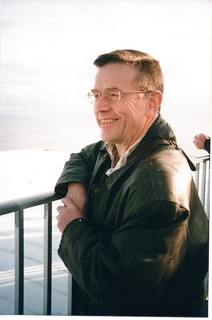 Robert became Librarian of the Royal Numismatic Society in 2010, and in the following year also for the British Numismatic Society, serving both societies in this capacity until his death.
He had been Librarian for the BNS from 1966 to 1981, and was awarded that society’s Sanford Saltus Gold Medal for 1999.
Robert became Librarian of the Royal Numismatic Society in 2010, and in the following year also for the British Numismatic Society, serving both societies in this capacity until his death.
He had been Librarian for the BNS from 1966 to 1981, and was awarded that society’s Sanford Saltus Gold Medal for 1999.
Robert’s passing leaves a huge hole in the world of numismatics, particularly in the field of tokens and other paranumismatica. Though small in stature Robert was a giant when it came to study and research. Much of his work was done in pre-internet times and he benefited greatly from his own vast library which fills the walls of two rooms in his house and partly occupies two other rooms as well. Having been a librarian by profession, he had a great love of books, and a passion to pass on his knowledge to others.
Robert was a keen attender at International Numismatic Congresses from 1979 onwards, and contributed articles to each of the published Proceedings of these, or to the Surveys of Numismatic Research in them. For most years from 1978 he attended the journées of the Société Française Numismatique in Rouen, usually with his numismatic friends Philip Mernick and the late Tony Merson. Often after these visits they would meet up with the French jetton and token specialist Jacques Labrot in Versailles.
I shall miss Robert and his wisdom, as will countless other numismatic students whom he has assisted over the years.
To read the complete article, see:
Robert Thompson, FRNS, MCLIP, FSA (1944-2017)
(https://numismatics.org.uk/2017/11/11/robert-thompson-frns-mclip-fsa-1944-2017/)
NEWMAN PORTAL ADDS ALASKAN ZNACHKI BULLETIN
“Znachki” is a word far outside the lexicon of most readers, but the Newman Portal user will find two useful entries on the subject. Dick Johnson’s Encyclopedia of Coin and Medal Technology first offers a formal definition:
“Russian medallic pinbacks, issued like most medallic items, for awards, commemorating anniversaries, outstanding deeds, souvenir or membership in some organization. Mostly made of lightweight alloys, as anodized aluminum, znachki are often enameled for color. Lenin was a popular portrait on znachki when Russia was communist. Collectors of znachki are called falerists, and have their own societies, both in the Soviet and elsewhere; the International Federation of Falerists is headquartered in Canada. The closest item in America would be a lapel pin and a pin collectors' society.”
I’m not sure if I’d rather be called a falerist or a philatelist (stamp collector), fortunately “numismatist,” in English at least, doesn’t sound nearly as creepy. Are there American collectors of znachki? Indeed there are, and Alaska dealer Dick Hanscom created a newsletter, The Alaskan Znachki Bulletin, in the late 1980s. Although not strictly numismatic, these are often collected in conjunction with tokens, and similar themes are illustrated on each. Political badges and related Americana are a staple of U.S. coin shows, and in Alaska you might also see “znachki.”
Image: From the June 1987 issue of Alaskan Znacki Bulletin, a pin protesting President Carter’s Alaskan anti-development policy.
Link to “Znachki” in Dick Johnson’s Encyclopedia of Coin and Medal Technology:
https://nnp.wustl.edu/library/dictionarydetail/517049
Link to Alaskan Znachki Bulletin on Newman Portal:
https://nnp.wustl.edu/library/publisherdetail/524076
NEWMAN PORTAL SEARCH: GEORGE H. EARLE
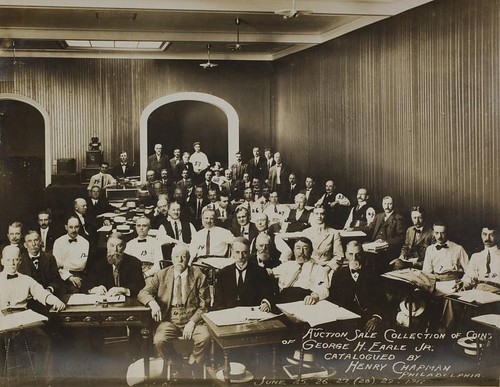
This week a Newman Portal searched for the George H. Earle auction sale catalog prepared by Henry Chapman in 1912. The Chapman brothers Henry and Samuel set up shop in Philadelphia in 1879, and, for reasons unknown, parted ways 27 years later. From there both continued to successfully market a number of important properties, into the 1930s.
The Earle sale catalog on Newman Portal, from the Hamelberg collection (ex. Bass), is an extraordinary copy. For starters, the catalog is plated, priced and named – and these three features alone place it in the top rung of early American auction sale catalogs. It only gets better from there. This copy is Henry Chapman’s bid book, used by the firm as a permanent record of the sale. Not all bid books were plated, and this example is exceptional as such. The number of photographic plates, 39, further indicates Chapman’s dedication in documenting the Earle cabinet.
Finally, the copy concludes with delightful ephemera – news clippings, sale addenda, and a photograph of the sale itself. What did an auction sale look like in the early 20th century? This photograph tells far more than a thousand words. One of the many spectacular items in the Hamelberg library, It is hard to imagine a more desirable copy among the Henry Chapman series.
Image: Photograph of the sale room at the Earle auction
Link to George H. Earle catalog on Newman Portal:
https://nnp.wustl.edu/library/auctionlots?AucCoId=20&AuctionId=511094
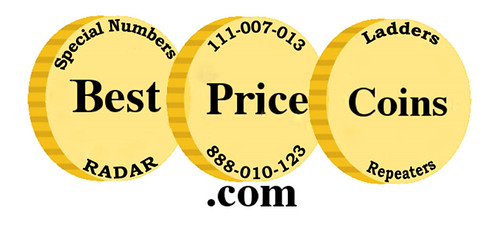
2018 ANS GALA DINNER
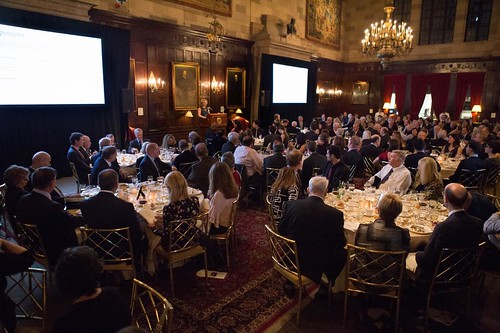
On Thursday, January 11, 2018, approximately 180 friends of the American Numismatic Society gathered to honor the Rosen Family with the Trustees’ Award at the Annual Gala Dinner, held at the Harvard Club in New York City.
The Society was delighted to acknowledge the family’s exemplary devotion and commitment. The Rosens have supported the Society and numismatics as an academic discipline since the early 1980s. Moreover, they have done so through the efforts of three generations, setting an exceptional example of commitment to the numismatic community. The Rosen Family was among the biggest contributors to the Society’s 1980s endowment campaign, which was undertaken by then ANS President Harry W. Fowler. A. A. Rosen was named as benefactor in 1982, followed by his son Jonathan, who was honored for his extraordinary financial support a year later, a practice he has continued to the present. Adam Rosen is now following in his father’s footsteps, both as a collector and a philanthropist. He is a serious collector of ancient art and coinage, sharing his father’s passion for Greek coins and especially electrum.
Jonathan Rosen joined the Society 45 years ago. He was elected Fellow in 1997 and has been a member of the Augustus B. Sage Society since 2006.
Executive Director Dr. Ute Wartenberg opened the evening by thanking the many supporters and sponsors of the Gala. Personal perspectives on the honorees were then offered by two longtime friends of the Rosens: Harlan J. Berk and David Hendin, First Vice President of the ANS Board of Trustees.
Hendin recounted how he had first met Jonathan Rosen in the early 1980s through a mutual friend, the late Ya’akov Meshorer, curator of Antiquities and Numismatics at The Israel Museum. The Rosen family’s generosity to that institution was already legendary. Haim Gitler, a guest at the event and chief curator of Archaeology and Numismatics at the Israel Museum, fondly recalled that 30 years ago, when he arrived at the museum on his first day of work, he found on his desk his first assignment: to catalog a collection of 1,300 ancient coins just donated by Jonathan Rosen.
As one of the foremost collectors of Archaic coinage, Jonathan Rosen championed the publication of his collection, which was prepared by Nancy Waggoner, the Curator of Greek Coins at the American Numismatic Society and published in 1983. The volume, Early Greek Coins from the Collection of Jonathan P. Rosen, is a classic that shows the breadth of collecting in one of the most obscure areas of numismatics.
Jonathan’s wife, Jeannette, has steadfastly encouraged his interests over their many years of marriage, and together they support many important cultural institutions, including the Metropolitan Museum of Art, the Brooklyn Museum, the Israel Museum, Bible Lands Museum, and the Morgan Library and Museum, where they have endowed a chair, the Jeannette and Jonathan P. Rosen Curatorship in the Department of Ancient Near Eastern Seals and Tablets. They also are major benefactors to such educational institutions as Amherst College, where they help fund the Chair of American Studies for Henry Steele Commager, and Emory, Yale, Cornell, and Columbia universities, along with the Institute for the Study of the Ancient World at New York University.
In addition to their extraordinary, generous support of the Society, the Rosens have greatly enhanced the ANS collections with many important donations. As Hendin remarked, “Academic numismatics and archaeologists, and of course, collectors, are lucky to have friends like Jon and his family.”
The ANS Annual Gala Dinner raised more than $210,000 for its research, publications and various programs. This includes $10,110 raised through its live auction, called by Melissa Karstedt of Stack’s Bowers Galleries. The eleven items included coins donated by Heritage Auctions, medals, wine, books, and other items donated by ANS members and Trustees, as well as a signed copy of Early Greek Coins from the Collection of Jonathan P. Rosen donated by Jonathan Rosen.

An unexpected surprise was the auction of a spectacular intricate gold necklace and jewelry ensemble on display from the Stack Family. The ensemble is made of ancient Greek and Roman coins, crafted by the premier 19th century French goldsmith-jeweler dynasty, the family Froment-Meurice. The ensemble has been in the Stack family for many years. Mr. Lawrence Stack promised to give whatever was raised over the reserve amount of $80,000 to the Society’s $4 million Campaign to Endow the Chair of the Executive Director. This ensemble was on display at the Gala with the intention of letting people know it would be available through auction at a later date. However, some guests were so enthusiastic about the pieces that they insisted on bidding on it that night. Renowned Sotheby’s auctioneer David Redden, who was attending the event, volunteered on the spot to handle the bidding. As a result of his spirited, and greatly appreciated, efforts, the necklace was purchased for $120,000, with $40,000 going to support the ANS campaign.
Past recipients of the Trustees’ Award include such notable numismatists and donors as Ms. Shelby White and Mr. Leon Levy, Mr. Jamie Stewart, Mr. Kenneth L. Edlow, Mr. George Kolbe, Mr. Q. David Bowers, Mr. Chester L. Krause, Mr. Donald G. Partrick, Mr. Harvey Stack, Mr. Victor England, Jr., Mr. Ira Goldberg, Mr. Larry Goldberg, Mr. Harlan J. Berk, Mr. Roger S. Siboni, Mrs. Marian Scheuer Sofaer and the Honorable Abraham D. Sofaer, Mrs. Elizabeth Forbes Hazard Scott and Mr. Stanley DeForest Scott, and Mr. and Mrs. John W. Adams, Anthony J. Terranova, and the Eric P. Newman Numismatic Education Society and the Newman Numismatic Portal.
Every year the American Numismatic Society raises critical revenue through Gala ticket sales, program advertisements, sponsorships, contributions, and the proceeds from a live auction. These funds are used to further the Society’s mission of supporting research and education in numismatics.
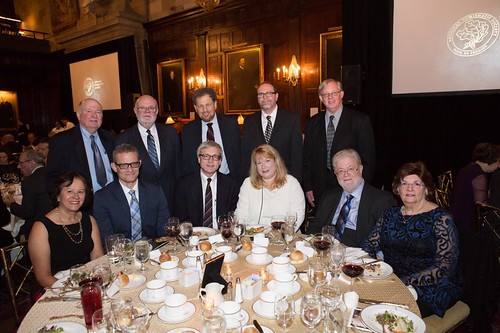
STANDING: Former ANS Librarian Frank Campbell, George Kolbe, David Menchell, David Fanning, Wayne Homren
SEATED: Rosa Campbell, ANS Librarian David Hill, Len Augsburger and his wife Debra Kurtz, Barry and Mrs. Tayman
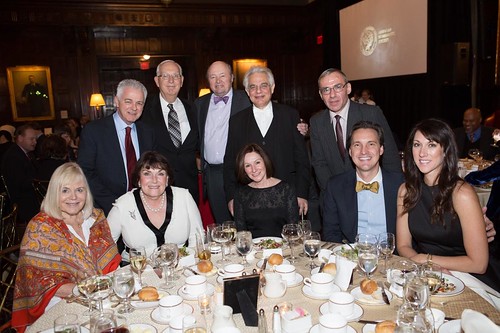
STANDING: Neil Musante, Dan Hamelberg, John Adams, John Lupia, and Lev Tsitrin
SEATED: Regina Adams, Connie Hamelberg, Cindy Musante, Skyler Liechty and his wife.
To read the earlier E-Sylum article, see:
WAYNE'S NUMISMATIC DIARY: JANUARY 14, 2018 : The ANS Gala (http://www.coinbooks.org/v21/esylum_v21n02a25.html)
ANS LECTURE: MARK TOMASKO ON BANKNOTE ENGRAVING
America became the world leader in bank note engraving by the 1860s. Through the American Bank Note Company, the United States system and style of bank note engraving provided bank notes for many of the world’s nations in the late 19th and early 20th centuries. Mark Tomasko, a collector, author, and researcher on bank note engraving, will lay out the process of designing, engraving, and printing bank notes and securities.
The presentation will be accompanied by samples of vignette artwork; bank note and securities models; vignette books; color books; engravers’ tools; steel dies, transfer rolls and printing plates; and progressive proofs of vignettes, litho tints, and bank notes. The event will start at 1:00 with lunch, the talk will begin at 2:00, followed by Q & A. Please RSVP to Emma Pratte at membership@numismatics.org or 212-571-4470, ext. 117. For more information on this talk, please visit the ANS website.
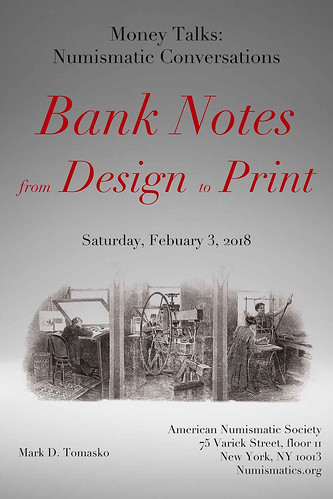
For more information, see:
http://numismatics.org/
For more on Mark's books, see these earlier E-Sylum articles:
NEW BOOK: THE FEEL OF STEEL - BANK NOTE ENGRAVING IN THE U.S. (http://www.coinbooks.org/esylum_v12n39a04.html)
NEW BOOK: IMAGES OF VALUE (http://www.coinbooks.org/v20/esylum_v20n09a03.html)
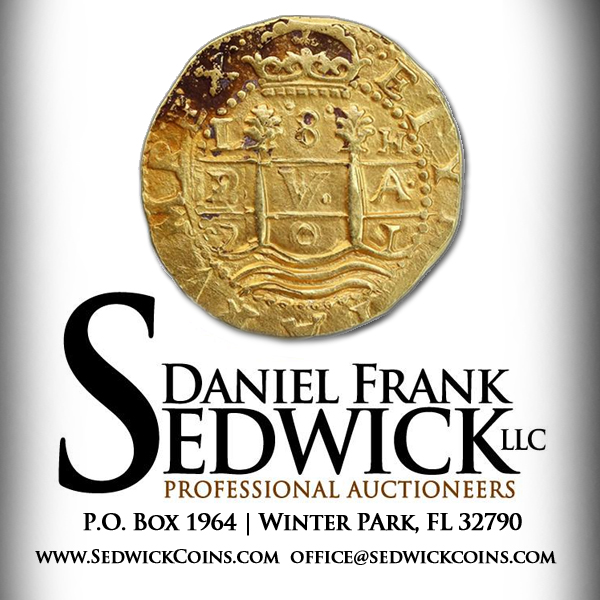
NOTES FROM E-SYLUM READERS: JANUARY 28, 2018
Fonrobert's U.K. Merchant Countermarked Dollars
Researcher Eric Hodge writes:
Regarding the query of Jules Fonrobert, I can only forward you details regarding the three UK merchant countermarked dollars he had. Fonrobert lot 6423 (Thistle Bank 4/9 with no reverse Thistle) was sold by Adolph Hess in May 1908 (Georg F Ulex of Hamburg sale) Lot 120, then J Schulman Amsterdam December 1908 lot 806 to Virgil Brand in his ledger 7 number 46053 etc.
Fonrobert lot 6422 (McFie Lindsay 4/6) was sold by Adolph Hess in May 1908 (Ulex) lot 122, then Schulman lot 803, then Brand ledger 7 number 46050 etc.
Fonrobert lot 6433 (Lanark Mills 4/9) was sold by Adolph Hess in May 1908 (Ulex) lot 121, then Schulman lot 801, then Brand ledger 7 number 46048 etc.
To read the earlier E-Sylum article, see:
NOTES FROM E-SYLUM READERS: JANUARY 21, 2018 : Query: Information on Jules Fonrobert Sought
(http://www.coinbooks.org/v21/esylum_v21n03a15.html)
On Donating Coin Books To Libraries
Jeffrey S Zarit writes:
I have read with interest of Tom Caldwell leaving The Numismatist in his doctor's office. I think I have another answer. I donate to my local library unwanted books, auction catalogs from around the world, and the like. My library has an outside drop for books, which I use often. I just put them thru the slot. I figure that sometime the library will have a book sale, this table a dollar per, that table two dollars per etc. The library gets the income and maybe there will be new collectors which our industry really needs. And upon entering the library there are two bookshelves of free books, both hardcover & paper books. There are two shelves of non fiction. Late last year, upon walking in I spotted some hard cover auction catalogs that I had donated, and they were not there on my next visit a week later.
From across the pond Eric Hodge agrees. He writes:
I am lucky not to have to visit the doctor, too often. However I do visit my local library, and that is where I leave surplus copies of the British magazine Coin News. Thanks for another great edition of E-Sylum this week.
To read the earlier E-Sylum article, see:
NOTES FROM E-SYLUM READERS: JANUARY 21, 2018 : The Numismatist Is In (the Doctor's Office)
(http://www.coinbooks.org/v21/esylum_v21n03a15.html)
THE MINT'S SO-CALLED FIRST SCREW PRESS
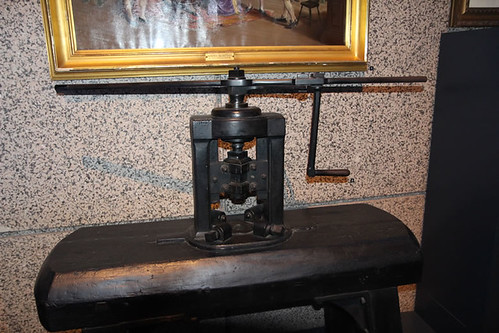
On display in the Philadelphia Mint is an old screw press which is supposedly the first screw coining press. According to an old family tale, Adam Eckfeldt and his father Jacob made the press at John Harper's factory and subsequently used it to strike the 1792 dismes and half dismes. Some may recall that this press was on display at several American Numismatic Association conventions in the 1980s and 1990s.
Using historical records, including the Mint's own account books and a 1797 letter from the Eckfeldt Estate recently purchased by Rob Rodriguez for his Resolute Americana Collection, I document the origin of this tale and then systematically debunk both its provenance and its attribution as the "first press." As noted in the article, I sent a copy to the Mint's curator, Dr. Robert Gohler, who kindly provided measurements of the press for use in the article. I am currently awaiting a response.

HEIDI WASTWEET’S MEDALLIC ART
Editor Wayne Homren earns our thanks for publishing notice of the web site of medallist-sculptor Heidi Wastweet in last week’s E-Sylum.
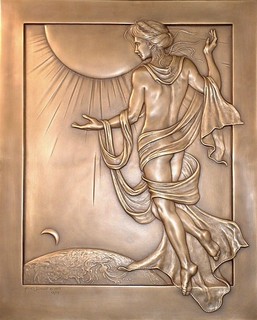 Heidi is at the top of her profession, the equal of a Laura Gardin Fraser, and approaching that of Malvina Hoffman. Laura Fraser is well known to collectors for her coins, Malvina Hoffman
is known for her full size sculpture in-the-round figures of all the types of human forms, 105 of these are in Chicago’s Field Museum. Malvina also created medals. Heidi has created hundreds of
medallic items but also creates sculptures.
Heidi is at the top of her profession, the equal of a Laura Gardin Fraser, and approaching that of Malvina Hoffman. Laura Fraser is well known to collectors for her coins, Malvina Hoffman
is known for her full size sculpture in-the-round figures of all the types of human forms, 105 of these are in Chicago’s Field Museum. Malvina also created medals. Heidi has created hundreds of
medallic items but also creates sculptures.
Medallists, it seems, can produce sculpture in-the-round, but not all sculptors can create the bas-relief models required for medallic items -- coins and medals. Heidi has mastered this glyptic art in addition to her talents as a sculptor. Her art medals, both commissioned items and studio productions are superbly designed and executed.
Private mints as well as the U.S. Mint have recognized her talent in creating coin relief models which must meet the exacting requirements of the coining press. But it is her art medals, unfettered by these restrictions, where her artistic muse reigns free. The result is miniature art objects, a pleasure to hold for their tactile quality and delight to view.
Heidi has taught dozens of students, sharing her knowledge of medallic techniques. She is also active outside her studio. She is president of the American Medallic Sculpture Association and is in her second four-year term as a member of the U.S. Treasury’s Citizens Coinage Advisory Committee. She champions the field of medallic art in many ways, in many avenues.
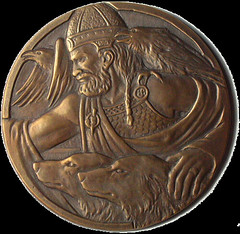 Collectors, if you are considering a new specialty in the numismatic field to persue, you would do well to consider art medals. Start with one of Heidi Wastweet’s creations. She has a
variety of subjects and images to choose from, undoubtedly one to please. No need to put this in a safe deposit box, this is art to view, to venerate. You will pick it up often, even to show to
friends. It’s a new art form, appreciated by all for its allure and charm. Art medals are highly collectible.
Collectors, if you are considering a new specialty in the numismatic field to persue, you would do well to consider art medals. Start with one of Heidi Wastweet’s creations. She has a
variety of subjects and images to choose from, undoubtedly one to please. No need to put this in a safe deposit box, this is art to view, to venerate. You will pick it up often, even to show to
friends. It’s a new art form, appreciated by all for its allure and charm. Art medals are highly collectible.
In addition to their artistic design you will discover art medals inherent rarity. Many are issued in editions, some as few as 10 pieces, others 15 or 20. But even 50 is a rarity compared to the large quantities of coins minted. Learn to appreciate this unique art, especially each medal’s patina – the coloring of the metal surface. Heidi prepares most of the patinas in her own studio. There is a lot of hand work for art medals in addition to their original modeling.
But be forewarned. After you own one you will want more, you will cherish it so much – and that’s the satisfaction of a collection.
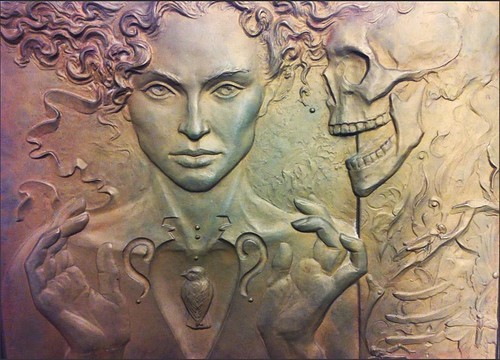
To read the earlier E-Sylum article, see:
FEATURED WEB SITE: HEIDI WASTWEET (http://www.coinbooks.org/v21/esylum_v21n03a31.html)
To visit Heidi Wastweet's web site, see:
http://www.wastweetstudio.com/
VOCABULARY TERM: DIE LIFE
Die Life. The number of pieces struck by a die before it is withdrawn from use. Rather than a measurement of time, die life is expressed in a number of pieces a given die strikes. There is no way of knowing in advance the life of a die; it can break on the first blow or still be serviceable 100 years and a million blows after it was made. The greatest enemies to dies are, of course, wear and rust, but dies also break, become sunken, pitted, damaged, all of which would prohibit their continued use – until they simply cannot strike satisfactory pieces.
Long die life. Perhaps there are more older dies, still serviceable, in the Paris Mint than anywhere else in the world. One, the original obverse of the first American medal, Washington Before Boston, 1789, has been in constant use, it is said, from 1790 until the early 1900s. (The reverse dies were replaced several times, creating at least three French versions of this medal.) But the original obverse has apparently lasted for more than 210 years! The Paris Mint has some original dies from the 14th century and has struck some of these side-by-side in soft tin for a series of modern restrikes. This is certain evidence of their excellent techniques of die storage and preservation.
The maximum life of coining dies in modern times range from 300,000 to 500,000 impressions. For medal dies it is considerably less (about ten percent of this for medal dies); in most cases dies outlast the number of medals required for most medal programs.
Here is a list of factors that influence the life of a die:
1) die wear,
2) type of steel,
3) degree of hardening,
4) impurities in the steel,
5) how quickly the die sinks,
6) high stress areas in the design,
7) hardness of blanks being struck,
8) method by which the die is hardened,
9) pressure established during each setup, and
10) protection afforded the die during storage.
CLASS 04.4
Looking for the meaning of a numismatic word, or the description of a term? Try the Newman Numismatic Portal's Numismatic Dictionary at: https://nnp.wustl.edu/library/dictionary

WALTER FREEMAN WEBB (1869-1957)
Walter Freeman Webb (1869-1957), was second generation American born on May 28, 1869 at Lockport, New York, son of Andrew R. Webb (1846-1906), a farmer, and Annie E. Miller Webb (1847-1904). His grandfather Joseph Webb (1804-1893), immigrated to America from England.
A a young boy living at Somerset, Niagara County, New York, Webb was an avid collector of coins and natural history.
In 1882, he began as an oologist selling bird's eggs as a teenager of 13. About this period we find noted coin collectors like Matthew Stickney buying bird's eggs and creating vast collections. This was the old European model of the Curiosities Cabinet that contained various categories of collectibles with coins and medals forming only a part.
The following year, 1894, he began publishing The Museum, A Journal Devoted to Research in Natural Science. Webb studied conchology, i.e., sea shells, and began to buy and sell as well as creating lists and descriptions which he eventually compiled and published into one of the best handbooks devised on this subject in America.
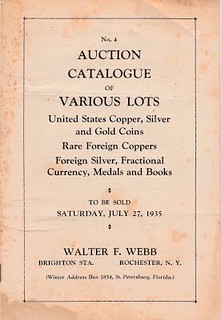

From February 1935 to November 1951 Webb held 80 coin auction sales.
In 1936, he moved to St. Petersburg, Florida.
He died at the age of 88 years old in June 1957 at Pinellas County, Florida.
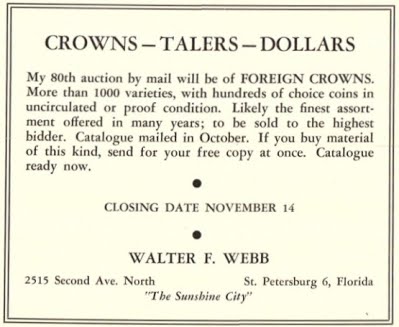
To read the complete article, see:
WEBB, WALTER FREEMAN
(https://sites.google.com/a/numismaticmall.com/www/numismaticmall-com/webb-walter-freeman)
The entire inventory of the Lupia Numismatic Library is for sale. Individual items will be available before the remaining archives are broken up into parcels sold at philatelic auctions in the U. S. and Hong Kong. Check NumismaticMall.com frequently as dozens of new items with estimates will be posted daily until everything is sold.
All inquiries will be given prompt and courteous attention. Write to: john@numismaticmall.com .
IN MEMORIAM: THEODORE V. BUTTREY, JR.
Renowned educator, numismatist and classicist, Theodore V. (“Ted”) Buttrey, Jr., died on January 9, 2018, eleven days after his 88th birthday. Born in Havre, Montana, as a child he attended the Peacock Military Academy in San Antonio, Texas, where he first encountered the coins of Mexico, a life-long interest. His secondary education was at the Phillips Exeter Academy in New Hampshire, after which he entered Princeton University, graduating magna cum laude in 1950 in Classics.
Ted’s publications, both books and articles, totaled well over 100. Most were concerned with topics in numismatics, especially antiquity, where the broad span of his interests encompassed Athenian coins, Republican denarii, Flavian coins, the coinage of Pescennius Niger, and even calculating ancient coin production. The modern era of numismatics also consumed much of his time, and a challenge to the authenticity of a collector’s gold bars of the Spanish-American southwest even got his name in the newspapers. But he never forsook his devotion to Classics, as evidenced by his early article, “Accident and Design in Euripides’ Medea,” published in AJP in 1958, while he was at Yale, and to an even greater extent by the television programs he produced for Michigan Media on Homer, Greek drama and theatre, Herodotus, Suetonius, and other classical subjects. As recently as 2015, in conversations at the International Numismatic Congress in Taormina, he discussed plans for a book on the role of fate in Oedipus Rex, arguing against the idea of unshakeable destiny.
While never thought of as one who suffered fools gladly, he was a charismatic teacher and approachable mentor, encouraging of younger scholars, as well as a witty and engaging raconteur. He will be greatly missed, but he leaves an immense legacy for his students, colleagues, and family to cherish and spread.
To read the complete article, see:
In Memoriam: Theodore V. Buttrey, Jr. (https://classicalstudies.org/scs-news/memoriam-theodore-v-buttrey-jr)
David Fanning
David Fanning writes:
Numismatics has lost a true gentleman and scholar.
Buttrey Store Scrip
Dave Schenkman writes:
Not mentioned is the fact that the store issued paper scrip, and in early times was connected to a coal company in Montana.
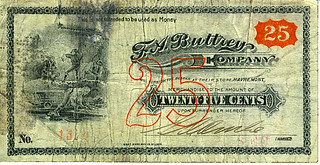
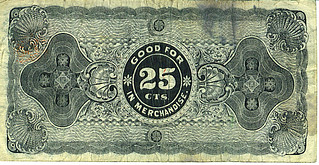
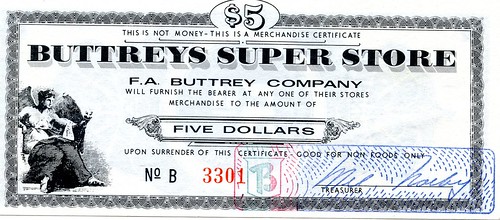
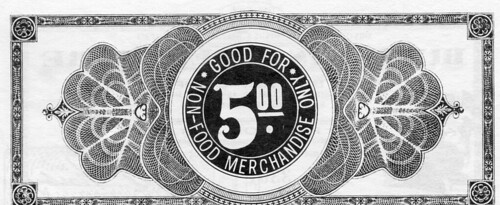
CoinsWeekly
On 9 January 2018, the numismatist Theodore (Ted) V. Buttrey died, only 11 days after his 88th birthday. We have thus lost a committed coin enthusiast, who never retreated to an ivory tower. He was most likely the only numismatist whose research made it to all major American newspapers and whose TV shows were broadcast at over 75 TV stations. And since he was also a kind person who dedicated a lot of time to young researchers, he had a lasting impact on many of today's numismatists.
To read the complete article, see:
Theodore V. Buttrey (1929-2018)
(http://www.coinsweekly.com/en/News/Theodore-V-Buttrey-1929-2018/4?&id=5137)
To read the earlier E-Sylum articles, see:
THEODORE V. BUTTREY (1929-2018) (http://www.coinbooks.org/v21/esylum_v21n02a05.html)
NOTES FROM E-SYLUM READERS: JANUARY 21, 2018 : More on Ted Buttrey (http://www.coinbooks.org/v21/esylum_v21n03a15.html)

KLEEBERG ON TED BUTTREY VS. JOHN FORD
You asked me to share my thoughts about Buttrey's bout with Ford. Of course, one should realize that Ted Buttrey made a large number of contributions in all sorts of diverse areas of scholarship. He began as a collector of Mexican coins, and contributed much on that; his scholarship was chiefly about ancient Rome. He determined the date of the introduction of the Roman denarius on the basis of the Morgantina excavations; he published excavation reports from Morgantina and Sardis; he was working on the denarii of Crepusius (the Crepusius series has numbered dies); he worked on the coinage of Pescennius Niger; his great showpiece was a lengthy lecture about Mark Antony, which lasted at least two hours - I sat through it twice and dearly wish it had been videotaped; the last two lectures I heard from Ted were on Caesar and Vespasian; he was working on a book on Sophocles; he got in a fierce debate about how many coins can be struck from a pair of dies; he re-worked a volume of RIC with Ian Carradice; he published several editions of a guide of Mexican coins with Clyde Hubbard; he was a leading advocate of the importance of collecting and studying coin auction catalogs and fixed price lists, and established for that purpose a vast trove of these at the Fitzwilliam Museum at Cambridge - and on and on.
Ted Buttrey performed an enormous service for the study of American numismatics by taking on John Ford; it was a lonely campaign that put him to much unnecessary expense, most notably when Ford filed a defamation suit against him. Ted was critical of Eric Newman drawing in his horns in the campaign; Ted felt that Eric had lost his nerve in the midst of the fight over the USAOG 1853 prooflike $20s.
When Ted was told he had won the Huntington Medal of the ANS for 1996, he said he would only accept if he was allowed to deliver a talk about Ford's False Western Gold Bars as his Huntington Lecture - and Bill Metcalf agreed to that. That lecture restarted the debate, which had been put on ice since the mid 1970s, and eventually destroyed the reputation of John Ford, Paul Franklin, and the Massapequa forgeries.
There are various strategies to attack the Massapequa forgeries, and Ted took the approach that I would call "The Magic Bullet" - he looked for one particular flaw that would bring down the entire edifice. He found it in the skewed pattern of finds - for decades very few gold bars had surfaced, and then, in the 1950s, boom, suddenly huge numbers surfaced and they all could be traced back to John Ford. As Buttrey commented, "Everybody was on the lookout for these bars yet only Ford found them - he must be the luckiest guy in the world."
I took a different approach, which I call "Death by a Thousand Cuts." I looked for many different criteria that could be used to demonstrate that the Massapequa objects were fakes - patterns in the serial numbers, weights, inconsistencies in the weights and finenesses (as in the Kohler bar where Franklin got his math wrong), or incorrectly dated pieces with or without the Internal Revenue tax stamp. It was a stroke of luck that Ford and Franklin never quite figured out the period that the Internal Revenue tax was imposed, so they produced many bars with bad dates. I eventually figured out the period (1864-68) - I was attending NYU law school at the time, hanging out in the law library, and I told myself that as a lawyer in training I should surely be able to find the statute that imposed the tax and the statute that repealed it. And I did.
It was also fortunate that the gold bars from the S.S. Central America came on the market and were extensively published by both Sotheby's and Christie's, so we had real bars to compare with the questionable ones - and the questionable ones failed test after test. I published a series of studies - one in the American Journal of Numismatics condemning the Kohler bar with the wonky math, another in Coin World about how the weird fineness runs with consecutive serial numbers, as contrasted to the Central America bars - and the stuff added up. So it was "Death by a Thousand Cuts" or, to mix my metaphors, "A Cask of Amontillado" as I shoved brick after brick into the wall that sealed off Ford, Franklin, and the Massapequa forgeries.
Finally, when Ford died, I did not want the conversation dominated by the praises that all too often are said about the deceased, so I wrote an obituary to change the theme and the conversation. And the obituary did accomplish its purpose - it got talked about. In the obituary I described how Ford blamed all inimical actions on Eric Newman, whom Ford regarded as a spider who sat in the center of a web in St. Louis, spinning plots against Ford. When the obituary appeared I received a note from St. Louis, reading in these words, more or less: "To: JMK; From: Spider; Re: Obit; Wow."
Some people have said to me that the obituary too extreme and over the top. One of the people who said that, was of all people, Ted Buttrey! In light of Ted Buttrey's criticism I have re-read my obituary of John Ford and considered if it should be toned down, but I decided against it - I really couldn't see where I could tone it down - it was my honest opinion, and if I toned it down it wouldn't accurately reproduce the picture as I saw it.
This is the story of the Mexican gold bars, more or less as Ted told it to me, including the sound effects:
When Ted Buttrey was a young curator at Yale, he received, out of the blue, a call from a New York City coin dealer who said that he had just acquired some very interesting Mexican gold bars, and since Ted was an expert on Mexican coinage would he look at them? Well Ted was a Republican guy, not a Colonial guy, but he still knew a fair bit about Colonial coins too. So in due time the gold bars arrive. Ted then asks around. He asks Henry Gruenthal, who said, "Well, I am not entirely sure but there is something about those Mexican bars that is not quite KOOOSHER!" (spoken in a German accent with a falsetto). He asked Henry Christensen who said, "Look Ted, I know you are a Republican guy, not a Colonial guy, but even a Republican guy should know that the imperial crown on the reverse die only appears in 1754 or later, and the tip of the cross is between the H and I in the legend only on coins dated 1761 or later, so there is no way these bars can date from 1744 and 1746."
Well Ted was young and naive, but he was smart enough to know that if he wrote a letter on Yale University notepaper expressing even the mildest sort of interest, the coin dealer (who was John J. Ford, Jr.) would say, "Look, Yale University is interested in these pieces" and use that to hype the bars- so he stayed shtum and eventually Ford called, and Ted said, "Look, I can't make anything out of these things," and Ford said, "Yeah, okay, ship them back." So Ted shipped them back.
Then the 1973 International Numismatic Congress was approaching, which would be held in New York and Washington, and Ted was looking around for a nice American topic, and he thought, why don't I sit down and research the Mexican gold bars? So he asked Ford if Ford could show him the pieces in his collection, and Ford took him to dinner. At dinner Ford told him the cock-and-bull story about the bars being found in a shipwreck off the coast of Florida, and Ted nodded and said, "Hmmm, very interesting." Ford then drove Ted to the house - when they arrived there was a ferocious watch dog that pounced at the car [RROOAAR!!].
Ford set Ted up at a table with a lamp and brought out the bars, and Ted noticed something important - there was a die break in the coin die that was used to mark the gold bars. So it was easy to show that all the gold bars were die linked, and because of the 1754/1761 problem they all could be condemned. Meanwhile Ford was popping down into his cellar and coming up with more goodies. Ted wished he could have gone into the cellar to see what was down there, but I suspect that if Ted had gone down into the cellar he wouldn't have emerged alive. Finally Ford came up with another bar - and he said, "Professor Buttrey, these bars have been so desirable that people have even begun to forge them - and here is an example of one of the forgeries - but you can see that it is a forgery from X, Y, and Z." It was a very crude and obvious fake. Ted was overcome with admiration for Ford - the man had even made a fake of his own fakes, so that he could condemn the crude fake and thereby, by implication, authenticate his own higher quality fakes - the "fake of a fake" ruse.
When Ted got back home he wrote a letter to Ford, thanking him for the dinner, but mentioning that he couldn't quite remember all the details about the bars being found in a shipwreck - could Ford tell him that again in writing? Ford fell for the bait and and wrote a letter containing the nonsensical story that the bars had been found in a shipwreck that dated from some time in the 1740s. Ted put that letter in a safe deposit box, because that dishonest story was the final nail in Ford's (and the bars') coffin.
Ted delivered his paper at the New York session of the International Numismatic Congress, and there were a few objections - one British dealer said very stuffily that one shouldn't use the Congress to settle commercial disputes etc. etc. (It was because of these objections that the paper was never published in the Congress proceedings. Clyde Hubbard tried to get Margo Russell to publish Ted's paper in Coin World, but Ford threatened litigation. As Tom Delorey said to me, "Margo Russell was impossible to buffalo - but Ford buffaloed Margo." Finally Eric Newman paid Miguel Munoz to cover the printing of it in a periodical in Mexico, and most of the extra copies ended up in Eric Newman's basement in St. Louis.)
Now Ted had been trying all along to get access to the Mexican bars at the Smithsonian, and Vladimir Clain-Stefanelli wouldn't allow it (just as he wouldn't allow Eric Newman to look at the prooflike USAOG 1853 $20 pieces) - he said there was a problem with the display cases, there were special security conditions, yada yada. The Congress that year had two sessions, divided between the ANS in New York and the Smithsonian in Washington and when Eric and Ted got to Washington they went to look at the Smithsonian display, and they mocked and laughed at the Western gold bars and the prooflike USAOG 1853 $20 pieces - and then they came to where the Mexican gold bars should be. But they weren't there! Clain-Stefanelli, who had been in the audience in New York, had run down to Washington and quickly taken them off display. But he wasn't that good at concealing the missing bars, because you could still see where the bars had been: the fabric had faded where it was exposed to light, leaving behind bar shaped imprints of all the Mexican gold bars. Later the Clain-Stefanellis put the Mexican gold bars back up on display and they remained there, deceiving the American public, until the 21st century. Good old Stef!
Ted said that if one attacks the bars one has to expect a lot of grief from everybody and if you receive any kudos it will, if ever, only be offered in secret. Ted had such an experience after he delivered his talk at the International Numismatic Congress in New York - Calico, the great Spanish dealer, came up to him, and in a very low voice said, "Professor Buttrey, I think you are quite correct - I have always been suspicious of those bars and I have always warned my customers against them." Ted replied, "Well, why didn't you speak out and do something about them? My chief interest is classical antiquity, and even though I know something about modern, Mexican, coins, I'm still a Republican guy, not a Colonial guy." Calico lowered his voice still further, speaking almost a whisper, hissing the sibilants: "Professssor Buttrey, you are young..."
Ford constantly threatened to sue people, but he never went through with his threats (I suspect he was too cheap to spend the money - he was really a paper tiger, but he did a good job of scaring a lot of people), except for one occasion, and that was ca. 2002, when Ford filed a defamation lawsuit against Ted Buttrey for Buttrey's statements at the debate that the ANA sponsored.
The lawsuit underwent a curious course. Ford began by suing Ted Buttrey in Federal court in New York. At the same time, they also started a case in Chicago. The judge in the federal court in New York asked, "Isn't there another place where this case could be tried?" and Buttrey's lawyer said, "Well, they have filed a federal case in Chicago..." whereupon the judge said, "Fine, go litigate it there." Then they show up in Chicago and the basis of the federal jurisdiction is diversity jurisdiction, which requires the litigants to be domiciled in different states; but Ted wasn't domiciled in a state, he lived in Cambridge, England, and there is no diversity with someone domiciled in a foreign country. So they were kicked out and told to go to state court in Illinois. It turns out that Illinois has a rule where you only get two bites at a cherry, and if it's your third time trying to file in a court you are out of luck. So Ford's case was thrown out of court there. And they couldn't refile in state court in New York, because New York has no long arm jurisdiction for defamation!
Interestingly, Buttrey made an offer - he would drop all the procedural maneuvers and go straight to trying the case on the merits, on the condition that the two sides agree that the losing side would pay the legal costs - "the Gloucester Rule," like they have in England. This offer was rejected.
To read the complete article, see:
Gold Bars, Glamorous Stories And a Battle Over Authenticity
(http://www.nytimes.com/2001/03/03/arts/gold-bars-glamorous-stories-and-a-battle-over-authenticity.html)
VAN RYZIN ON SELMA BURKE AND JOHN SINNOCK
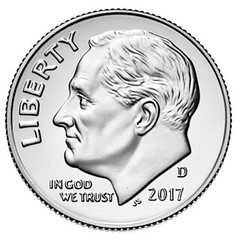 In 1993, I took some time away from the American Numismatic Association convention in Baltimore and drove to Dr. Selma Burke's home/studio in New Hope, Pa. to interview her on the topic
of her claim that her design was used on the Roosevelt dime.
In 1993, I took some time away from the American Numismatic Association convention in Baltimore and drove to Dr. Selma Burke's home/studio in New Hope, Pa. to interview her on the topic
of her claim that her design was used on the Roosevelt dime.
My article, from which the below is adapted, ran in the Nov. 30, 1993 issue of Numismatic News as "Who Really Designed the Roosevelt Dime?" Much of what appeared in the Atlas Obscura article, "Who Really Designed the American Dime?," referenced in The E-Sylum January 21, 2006 matches with what Burke told me as to the design competition she won; her drawing Roosevelt from life; her problems with getting him to pose; and Eleanor Roosevelt's later visit and comments about Burke's work making FDR look too young.
There is a little bit more to Burke's claim, not contained there, but expressed to me during the interview. I was also able to take a b+w photo of her original drawing, which was done on brown butcher paper she had obtained from an A&P grocery store and took with her to her sittings with the president. (Burke was in her 90s when I talked to her, but was still very sharp.)
She said It wasn't just the similarity between the image on the dime and her work that led her to believe she hadn't been properly credited. She told me she received a phone call late one evening (in 1945, during the time the design was being prepared at the Mint) from a Ruth Wilson, at the Recorder of Deeds office, where Burke's plaque was to be displayed.
Burke related of this call:
"The reason why I knew that Mr. Sinnock had gotten it [her Roosevelt sketch] from there [the Recorder of Deeds office] was that Ruth Wilson had called me in the middle of the night, in New York, to tell me that this man, Sinnock, and Marshall Shepard [Recorder of Deeds for the District of Columbia] were making a deal that he had taken the drawing to the Mint. Ruth Wilson said, 'You'd better come to Washington because Marshall Shepard and Sinnock are doing a thing on you.'"
Burke said she was acquainted with Wilson as she and Wilson were godparents to the daughter of a Mary Wilson.
"She [Ruth Wilson] felt very close and she had to let me know what was going on. I was sleeping, and I said, 'I am not going to Washington. I won this thing [the contest for Recorder of Deeds office plaque of Roosevelt]' No, I just took a stand."
As in the Atlas Obscura article, Burke claimed to me that her subsequent attempt to gain credit for the design led to her being investigated by the feds, namely J. Edgar Hoover's FBI.
I talked to Burke one additional time, by telephone, shortly before her death in 1995, and later was invited to speak at an exhibit of her works in Austin, Texas. I found her to be a very gracious lady, and am convinced she truly believed until her death that she designed the dime.
I do think, but have no proof of it, that there was some truth behind her story of the late night phone call, which helped bring her to her conviction. Perhaps, if it occurred, it wasn't even Sinnock who requested to see the design, and even it was, it doesn't mean the dime's image was lifted from her work.
Whether she deserves credit for the dime or not (and there are additional arguments for not presented in the Atlas Obscura article by Christina Ayele Djossa and here by Dick Johnson), there can be no doubt Dr. Selma Burke's place in history as one of the nation's leading sculptors is forever secured.
Bob adds:
"The Marshall Shepard she mentioned was Recorder of Deeds for the District of Columbia at the time of her plaque's unveiling, in 1945. He appears in an Associated Press photo with the plaque along with Burke and President Truman."
Susie Nulty writes:
I enjoyed reading the latest edition of The E-Sylum and was especially interested in the "Burke vs. Sinnock: Who Designed the Dime?" article. You may be interested in a site we host gratis titled, "Richard's Roosevelt Review" put together many years ago (1997) by Richard Bateson. It is full of numismatic details and covers the design issue your article examines on the "Roosevelt Dime" page just after the "Introduction."
To visit Richard's Roosevelt Review, see: http://www.richardsrooseveltreview.net
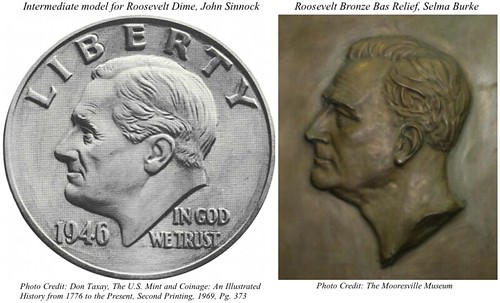
Sinnock's Model and Burke's Plaque
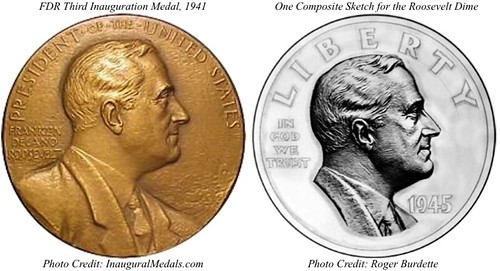
Sinnock's Roosevelt Third Inauguration Medal
Roger Burdette wrote:
As you note, Ms. Burke had nothing to do with the FDR dime.
The final portrait was the outcome of two meetings between Sinnock and sculptor Lee Lawrie, who had been “deputized” by the Commission of Fine Arts to review the dime designs.
To read the complete discussion, see: The Selma Burke Controversy Lives on Long After the 1940s (https://www.ngccoin.com/boards/topic/348290-the-selma-burke-controversy-lives-on-long-after-the-1940s/)
To read the earlier E-Sylum articles, see:
VAN RYZIN ON SELMA BURKE AND THE ROOSEVELT DIME DESIGN (http://www.coinbooks.org/esylum_v09n07a05.html)
BURKE VS. SINNOCK: WHO DESIGNED THE DIME? (http://www.coinbooks.org/v21/esylum_v21n03a13.html)
THE BOOK BAZARRE
INTERVIEW WITH COIN DESIGNER JOEL ISKOWITZ
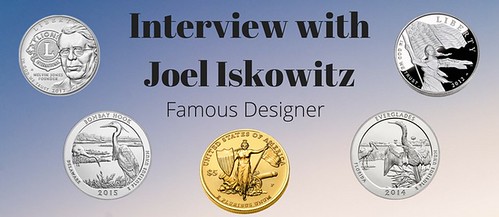
Joel Iskowitz is one of the most prolific and accomplished American artists working today. He has created countless artworks from coins, stamps, and medals to paintings, album covers, and book and magazine illustrations.
His work has been displayed everywhere from the White House, United States Capitol, and the Pentagon to NASA, the Smithsonian and other major museums around the world, and the Air Force Art program. It has even flown in space and been presented to astronauts. He has also received numerous awards and honors for his work and in 2011 was inducted into the Hall of Fame of Hunter College, where he graduated in 1968 with a degree in fine arts.
To read the complete article, see:
Interview With Joel Iskowitz: An American Narrative
Artist and Coin Designer (https://www.moderncoinmart.com/info-vault/articles/interview-with-joel-iskowitz-an-american-narrative-artist-and-coin-designer.html)
JOSHUA MCMORROW-HERNANDEZ EXPLORES EXONUMIA
Fred Holabird:
“Right now, so-called dollars are hot,” he says. “But what’s ‘hot’ comes and goes.”
In the 1980s, gaming chips reigned. So, where are the opportunities today?
“Items they haven’t written books about,” he says. “There are lots of Mardi Gras doubloons that were dumped during the parades in New Orleans, but there isn’t a book about those and you can buy them for perhaps a quarter or so each.”
Holabird says there’s plenty for new medal and token collectors to enjoy.
“There’s so much material out there, meaning you can pick your favorite topics, including sports, history, military – you name it.”
Dr. William Kiser:
“Most tokens are rare,” confirms Kiser, a 30-something who started collecting tokens when he was seven years old after discovering an old New Mexico token as a metal-detecting find in an early 1900s-era dump in southern New Mexico. “For example, when it comes to New Mexico, there about 2,000 different tokens known from that state, and about 1,000 of those have only one to three pieces known to exist. This makes most tokens far more rare than even the rarest of coins.”
Kiser understands this firsthand, too. He wrote New Mexico Trade Tokens, a reference book and price guide drawing from his nearly lifelong passion for tokens from the state known as the Land of Enchantment.
To read the complete article, see:
Exploring Tokens & Medals Through the Eyes of a Longtime Coin Collector
(https://coinweek.com/coins/coin-collecting-strategies-2/exploring-tokens-medals-eyes-longtime-coin-collector/)
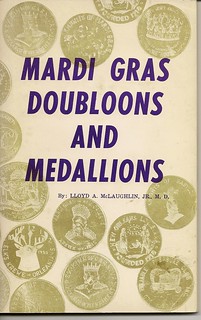
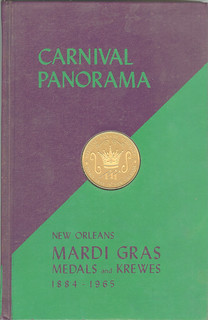
Some older Mardi Gras references

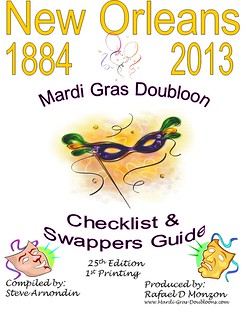
Some more recent Mardi Gras catalogs
To read the earlier E-Sylum articles, see:
WHY THERE WILL ALWAYS BE MARDI GRAS DOUBLOONS (http://www.coinbooks.org/esylum_v09n14a21.html)
BOOK ON MARDI GRAS DOUBLOONS (http://www.coinbooks.org/esylum_v09n15a11.html)
QUERY: INFORMATION ON MARDI GRAS DOUBLOONS SOUGHT (http://www.coinbooks.org/esylum_v12n36a19.html)
MORE ON MARDI GRAS DOUBLOON LITERATURE (http://www.coinbooks.org/esylum_v12n37a10.html)

NORTH CAROLINA WRECK YIELDS GOLD COINS
Divers found 14 gold coins and 24 silver coins in a spot “no bigger than a cigar box.” All predate the ship’s sinking and include one British coin that experts say could be worth $100,000. Other gold coins in the collection are valued in the $10,000 to $12,000 range, officials said.
James Sinclair, a marine archaeologist involved in project, says finding gold coins proves the team is in the right spot.
“This evidence supports reports that valuables, including gold and silver, were aboard the Pulaski when she sank,” Sinclair said in a statement.
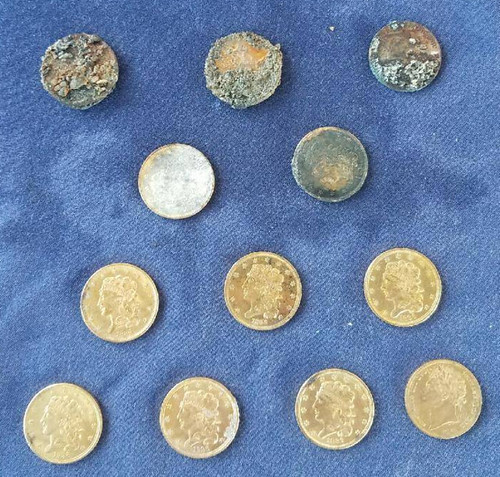
Some of the recovered coins have yet to be conserved
Those involved in the project have one particular passenger in mind: Charles Ridge, a man who survived but lost $20,000 in the disaster, all of it in gold coins.
The coins were uncovered as part of joint project by Blue Water Ventures International and Endurance Exploration Group, two publicly traded companies that expect to find a treasure trove of valuables brought aboard the doomed luxury ship by wealthy passengers.
Keith Webb of Blue Water Ventures said in an interview Friday the 14 gold coins are not Ridge’s fortune.
“When we find his money, it won’t be the size of a cigar box. It will be the size of a chest,” said Webb. “We will find it, I assure you, and it will be in one pile. And that will be gold coins with a specific history attached – an actual story of a man whose riches are lost and a woman still committed to marry him…. It’s romantic. It’s exciting.”
Webb predicts they’ll find thousands of coins that could be worth millions. So far, he says they’ve found 70 U.S., Spanish and Mexican coins during a half dozen visits.

To read the complete article, see:
Divers find a stash of rare gold coins at the site of 1800s shipwreck off NC coast
(http://www.charlotteobserver.com/news/local/article196911119.html)
To read the earlier E-Sylum article, see:
NORTH CAROLINA COAST WRECK MAY BE THE PULASKI (http://www.coinbooks.org/v21/esylum_v21n03a26.html)
MORE ON RAYMOND'S EASY DISPLAY SYSTEM
Regarding last week's article by David Lange on Wayte Raymond's Easy Display System coin holders, Andy Singer writes:
I have one of those Wayte Raymond boxes illustrated in the last esylum. The trays in mine have been modified with balsa wood dividers to hold varying numbers of coins.
Jeff Sutton writes:
I saw the article in The E-Sylum about Wayte Raymond’s Easy Display system. It is the first I have heard mention of them in a long time. Years ago, I acquired two of the cabinets from the Robert L. Weber collection complete with many coin holders (and coins!). The only public information I could locate on Mr. Weber’s coin collecting adventures was a catalogue for a mail bid sale administrated by Mr. Raymond on December 13th, 1939.
I gave one of the cabinets to fellow collector and kept the better condition example for displaying most of the Weber coins still in my possession. Each cabinet had ten trays as shown in Dave's pictures and a variety of individual coin holders.
According to his son, Mr. Weber frequented Wayte Raymond’s shop in New York and acquired many numismatic pieces directly from him.
Most of the coin holders appear somewhat standardized in a few sizes with a greater variety of hole diameters to accommodate the individual coins. Some of the holders are blank but most have a very elegant hand script lettering naming the coin and country of origin. I do not know if the lettering was applied at the shop with each purchase or if Mr. Weber added the description at home.
I could not tell from the article if any of the holders from David Lange's acquisition survived so I have attached a few pictures of mine for reference just in case. I would appreciate knowing if any of the coin holders have the same lettering style, which would answer my question of where the lettering was applied.
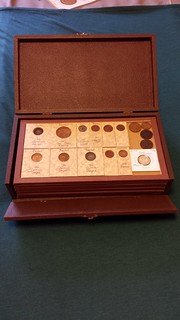
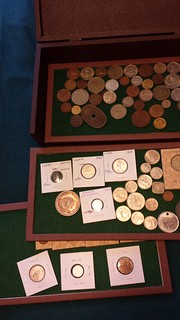


Dave Lange writes:
The handwriting is indeed elegant and something seldom seen today. I don't have any of the individual holders, so I can't make a direct comparison. The holders were sold plain by Scott Stamp & Coin, the original distributor for Raymond products, and then later by Raymond's own company. Typically, it was up to the user to perform the desired lettering, though any coin shop could have done that for its own inventory of coins, too.
The vintage ads in my book feature lettering by Dorothy Mosher, sister of prominent numismatist Stuart Mosher. She worked for Raymond as his one-woman art department, and her craft appears on his various non-National coin albums. Her script is somewhat similar to that seen on your coin holders, and it's perhaps too much to hope that she did the writing herself.
Jeff adds:
I also counted my holders, 33 blank and 60 with the specific name of the coin and country of origin.
The ad provided by David indicated two widths for the holders. I have four widths: 50mm, 47mm, 26mm, & 23mm, all the same 63mm height.
There are also over a dozen different hole diameters ranging from 42mm to 13mm.
To read the earlier E-Sylum article, see:
RAYMOND'S EASY DISPLAY SYSTEM COIN HOLDERS (http://www.coinbooks.org/v21/esylum_v21n03a18.html)
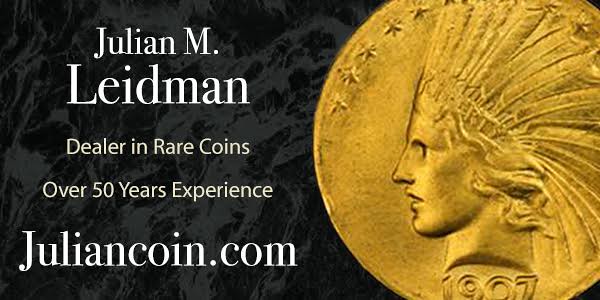
QUERY: WAS THIS GASPARRO’S LAST MODEL?
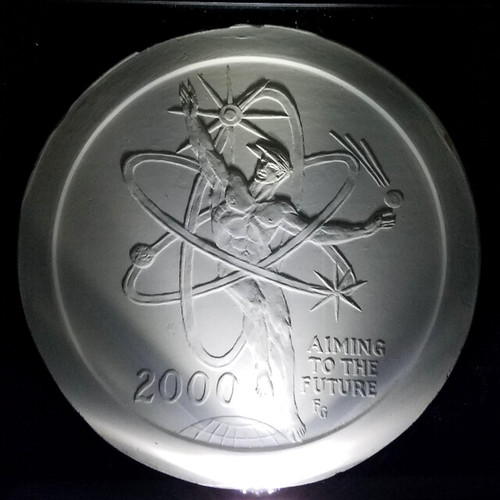
Owner of this plaster model is asking for more information about it. It was among other plasters and medals by Frank Gasparro. I am unfamiliar with this particular piece and wonder if it was indeed, struck as a medal. Theme of the medal was Y2K, the beginning of the third millennium.
The plaster is cast from a clay model, in Gasparro’s creative style, and signed with his familiar FG initials. It could have been made in 2000 or any time earlier. He died in September 2001. I know of no other piece made by him this late in his career so this may be his last medallic creation.
Gasparro retired from the Philadelphia Mint in January 1981. I know he had a studio in his home as I visited him in 1996 with film producer Mike Craven for a filmed interview. During his retirement he created a Bahamas Columbus Coin for the Franklin Mint, an ANA Convention Badge in 1991, a series of eight medals for the Providence Mint, and at least eight medals on commission including his own portrait medal.
Does anyone recognize this design on an existing medal? If not the plaster model was done on speculations – not on commission – therefore not an existing medal.
QUERY: S.B. CHILDS TOKEN DESIGN SOURCE SOUGHT
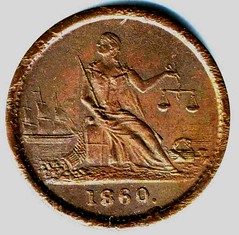 Dave Bowers, who with other members of the Civil War Token Society is working on The Specialized Collection of Civil War Cards, is exploring in depth the several dozen engravers and
minters of Civil War tokens and the biographies of nearly 1,000 different merchants who issued these. This is intended as a supplement to U.S. Civil War Store Cards, recently published and
available on the CWTS website.
Dave Bowers, who with other members of the Civil War Token Society is working on The Specialized Collection of Civil War Cards, is exploring in depth the several dozen engravers and
minters of Civil War tokens and the biographies of nearly 1,000 different merchants who issued these. This is intended as a supplement to U.S. Civil War Store Cards, recently published and
available on the CWTS website.
Among the most curious of store cards is the illustrated die 1356, created a year before the 1861-1865 war, but numismatically “adopted” into the series. This was issued by S.B. Childs, a Chicago maker of store cards—one of the major issuers of Civil War tokens. However, this particular token is very curious and is different from any other of the hundreds of dies in the Civil War token series. It is not a rare image and was used on the store cards of a number of Illinois merchants and one in Wisconsin.
The iconography is unique for a CWT. It shows a goddess or allegorical lady at seaside (perhaps lakeside as Chicago is on Lake Michigan) holding the scales of justice in her left hand and cradling a sword with her right arm. She is seated on a bale, perhaps emblematic of commerce, while in the background is a fully-rigged sailing ship, perhaps also evocative of commerce. At once side is an overflowing cornucopia, suggesting plenty. On the ground to the right is a Roman fasces on its side.
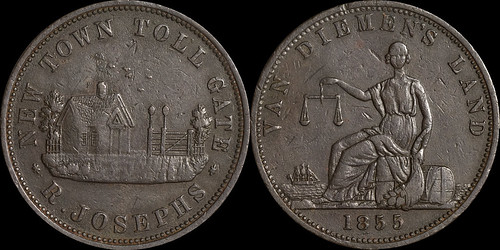
Was this motif specifically inspired by a coin, medal, bank note vignette, painting or other object of art? A penny token of Van Diemen’s Land (Tasmania), 1855, comes close. There are countess depictions of Justice seated and standing, holding scales, on obsolete bank notes but none even closely match the Childs token. Can anyone suggest a more specific origin or inspiration? If anyone has any ideas, Dave would be glad to learn of them. Contact him by e-mail at qdbarchive@metrocast.net.
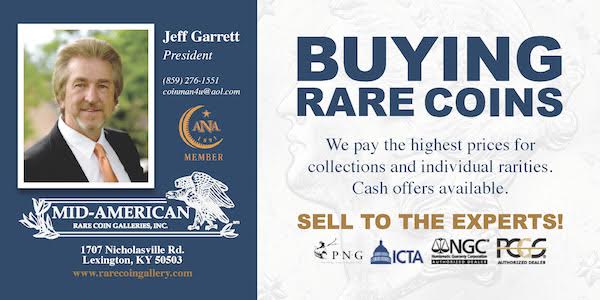
NUMISMATIC NUGGETS: JANUARY 28, 2018
Celtic Imitation Denarius
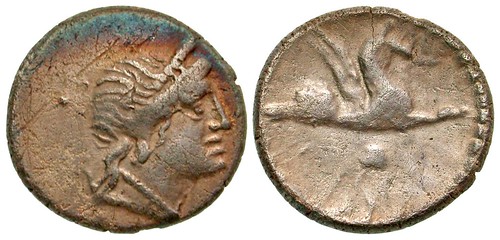
Middle Danube, Eravisci. Imitating L. Papius. End of the first century B.C. AR denarius. Rare. Ex RBW collection (not in previous sales).
Middle Danube, Eravisci. Imitating L. Papius. End of the first century B.C. AR denarius (17.37 mm, 3.24 g, 6 h). Diademed head of Venus right; copying a Roman Republican denarius of C. Naevius Balbus (Crawford 382/1) / Gryphon right; below, amphora; copying a Roman Republican denarius of L. Papius (Crawford 384/1). cf. Crawford 382/1 and 384/1; cf. Freeman pl. 29, 21. EF, toned. Rare
To read the complete lot description, see:
Lot 005. Middle Danube, Eravisci. Imitating L. Papius. End of the first century B.C. AR denarius.
(https://www.agoraauctions.com/listing/viewdetail/38826)
American Large Cent Watch Fob
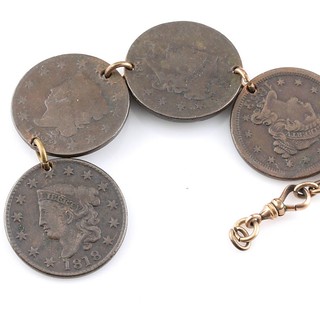
An antique watch fob made from four American large cent coins that have been drilled. Length: 5 1/2". Total weight: approximately 1.36 ozt.
To read the complete lot description, see:
Antique Watch Fob Made from Four American Large Cent Coins
(https://www.ebth.com/items/7963051-antique-watch-fob-made-from-four-american-large-cent-coins)
Love Token Pin with Seated Liberty Dimes
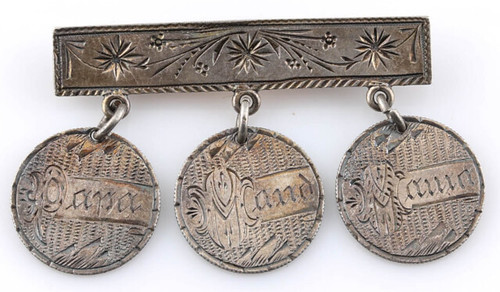
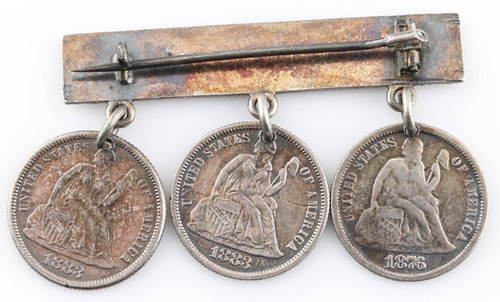
An antique love token pin made with a group of three American silver seated Liberty dimes that have been drilled and engraved. Length: 1 3/4". Total weight: approximately .32 ozt.
To read the complete lot description, see:
Antique Love Token Pin Made with Silver Seated Liberty Dimes
(https://www.ebth.com/items/7962796-antique-love-token-pin-made-with-silver-seated-liberty-dimes)
Ceylon Slave Island Mills Token
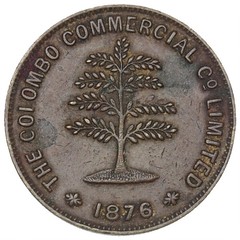

Ceylon, Slave Island Mills, Colombo Commercial Co. Ltd., Token 1876, Pridmore-22
To read the complete lot description, see:
1805/?5214 Ceylon, Slave Island Mills, Colombo Commercial Co. Ltd., Token 1876, Pridmore-22
(https://bruun-rasmussen.dk/m/lots/F11AAC740041)
To read the complete Wikipedia entry, see: Slave Island (https://en.wikipedia.org/wiki/Slave_Island)
1916 German occupation of Persia Banknote
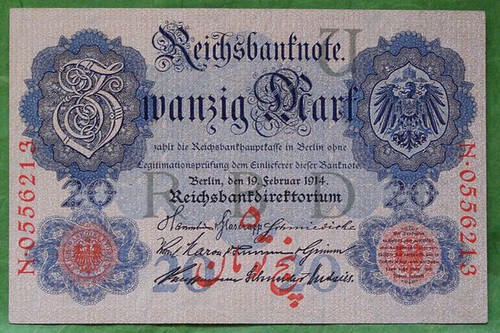
Note from the auctioneer:This is a genuine overprint on 20 marks 1914. The serial number is only 27 numbers away from the banknote used in the Rosenberg catalogue (17 Auflage). Also the certificate from Mr. D.B. Hollander is genuine. Hollander was a member of the board of the Society of Paper Money Collectors. All the 20 mark banknotes with overprint start with letter N.This is a very rare genuine banknote.Particular banknote issued in IRAN in 1916/17 (old dated 19/02/1914).Size in cm: 14.2 x 8.9 cm
To read the complete lot description, see:
Iran - German occupation of Persia 1916-1918 - 20 marks /
5 Toman (1916) - Rosenberg 488 - Pick M3 (https://auction.catawiki.com/kavels/15542545-iran-german-occupation-of-persia-1916-1918-20-marks-5-toman-1916-rosenberg-488-pick-m3)

YEAR OF FOUR EMPERORS DENARIUS RECOVERED
PJ police have managed to recover a unique Roman coin that was stolen from a religious sanctuary in Alijó, Vila Real, Northern Portugal, over 30 years ago in 1985.
The coin was recovered after being put up for sale along with nine other Roman coins at an auction in Madrid, Spain, with a starting price of seven thousands euros. The collection of coins were part of a haul of 65 coins found in 1985 inside a clay pot unearthed during expansion works at the Nossa Senhora da Piedade Sanctuary in Sanfins do Douro, in Alijó.
Despite the theft having been widely covered in the regional press at the time, the coins were never found, which police now know is because they had been taken straight out of Portugal and sold at a market in Vitória, Spain.
The subsequent sale at auction in Madrid was spotted by an eagle-eyed Portuguese historian and Professor at Porto University, who alerted the police of its catalogue listing. The lot was described as an “extremely rare Roman coin, a one-of-a-kind Denarius minted during the civil war of the Roman empire in the years 68-69 A.D., known as the year of the four emperors, and with a bidding price of seven thousand euros”.
In turn, the police triggered the necessary mechanisms to bring the ancient coin back to Portugal.
It has now been handed over to an archaeology museum in Braga. In a further twist, the PJ revealed, “unequivocal proof that this Denarius was an integral part of the Alijó treasury was only possible thanks to a 1983 study carried out by the aforementioned university professor even before the theft occurred, by comparing photographs taken at the time of the entire set of coins, with photographs sent by the Spanish police authorities, which allowed the recovery of not only that Denarius, but also nine other coins.”
To read the complete article, see:
PJ police recover unique Roman coin stolen over 30 years ago
(http://www.theportugalnews.com/news/pj-police-recover-unique-roman-coin-stolen-over-30-years-ago/44573)
MORE ON ANCIENT CLOTHING STYLES
 Does this lorica segmentata make me look heavy?
Does this lorica segmentata make me look heavy?
After that great article on Roman artifacts, I could not resist. In addition to having some nice ancient coins of the Roman Empire -- including here in Spain -- I can also dress about six people in Roman garb. This lorica segmentata plate armor was eventually replaced by chain mail because it tended to fall apart after a lot of use.
I stand in front of Segovia's Roman acueduct built of some 20,000 pieces of granite about 1900 years ago. The acueduct is the mintmark seen on Spain's coins of centuries ago.
Roman-Style Hammered Coin Dies
Gary adds:
I recently donated to the Royal Mint of Segovia this pair of hammered dies as were used from Roman times clear into the 1700s in places. The stump is Spanish but the dies were hand-made in California. At some point a living history demonstration will have an actor in historical clothing making sample coins of tin.
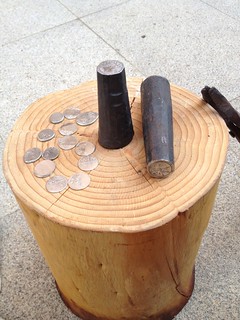
To read the earlier E-Sylum article, see:
CLOTHING ON ANCIENT COINS (http://www.coinbooks.org/v21/esylum_v21n03a25.html)
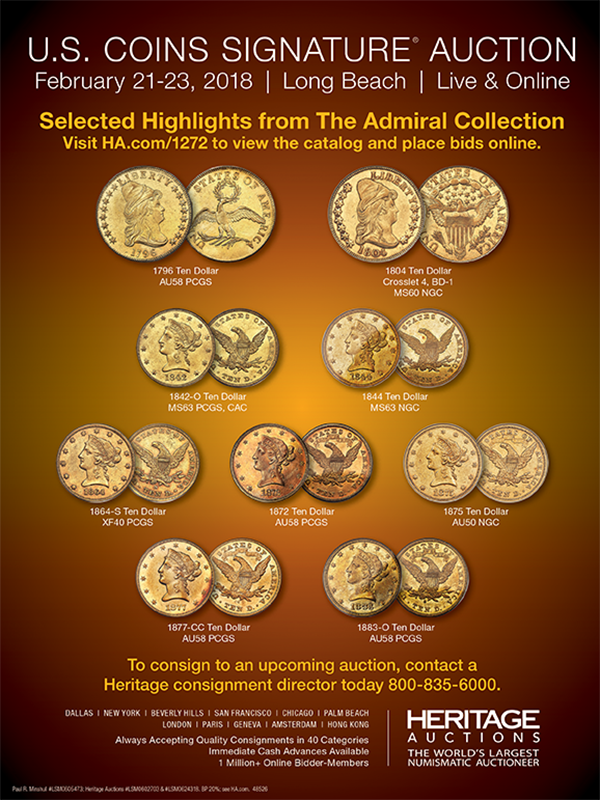
CNG’S TRITON XXI POSTSALE REPORT
Classical Numismatic Group of Lancaster, Pennsylvania and London, England held their annual Triton auction in conjunction with the 46th Annual New York International Numismatic Convention (NYINC) on January 9-10, 2018. The pre-sale estimate total for Triton XXI was $10,209,500 million, and the total of actual prices realized was $14,971,166, including the buyer’s fees, with 98% of all lots sold.
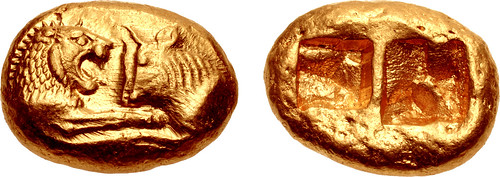
Triton XXI, Lot: 501. Sold for $132,000 against a $30,000 Estimate.
KINGS of LYDIA. Kroisos. Circa 564/53-550/39 BC. AV Stater (18mm, 10.79 g). Heavy standard. Sardes mint. Regular issue. Confronted foreparts of lion and bull / Two incuse squares. Berk 2; Le Rider, Naissance, pl. V, 2; Traité I 396; SNG Ashmolean 759; SNG von Aulock 2873–4; BMC 30; Boston MFA 2068–9; Gulbenkian 756. Choice EF, lustrous.
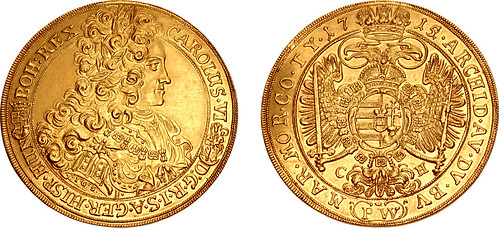
Triton XXI, Lot: 1063. Sold for $444,000 against a $300,000 Estimate.
HUNGARY, Holy Roman Empire. Magyar Királyság (Kingdom of Hungary). Károly III (VI). 1711-1740. AV 10 Dukat (44mm, 34.88 g, 12h). Pozsony (Pressburg / Bratislava) mint; Paul Wodrich, mintmaster. Dated 1715/2 CH PW. CAROLVS · VI D : G · R · I · S · A · GER · HISP · HUN BOH : REX, laureate, draped, and cuirassed; crowned coat-of-arms to left, to right, Madonna seated on crescent, holding infant Christ / · ARCHID · AV · DV · BV · MAR · MOR · CI · TY · 17 1(5 over 2), crowned double-headed eagle with crowned and collared coat-of-arms on breast, holding sword and scepter; C H flanking tale; PW in cartouche below. Huszár –; KM –; Friedberg 176a (this coin cited and illustrated). In NGC encapsulation graded MS 63. Superb surfaces and luster. Unique.
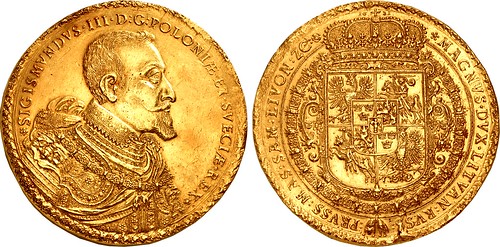
Triton XXI, Lot: 1127. Sold for $2,160,000 against a $2,000,000 Estimate.
One of the most expensive world coins ever sold!
POLAND, Monarchy. Zygmunt III Wasa. 1587-1632. AV 100 Dukat (70mm, 349.49 g, 12h). Commemorating the victory over the Turks at Chocim (Khotyn). Bydgoszcz (Bromberg) mint; Jacob Jacobson van Emden, mintmaster, and Samuel Ammon, engraver. Dated 1621 II VA SA. * SIGISMVNDVS · III · D : G : POLONIÆ · ET · SVECIÆ · REX *, armored and draped bust right, wearing ruff and collar of the Order of the Golden Fleece; all within oak wreath border / * MAGNVS · DVX · LITVAN : RVSS : : PRVSS : MAS : SAM : LIVON : ZC’ : *, crowned ornate coat-of-arms within collar of the Order of the Golden Fleece; II and SA within garnish; all within oak wreath border. Czapski 1414; Kopicki 1441; Kurpiewski 1770; Gumowski –; KM H43; Friedberg 72 (this coin cited); Kaleniecki p. 108 (this coin cited). EF, scattered handling marks and hairlines, die break on reverse. One of six total specimens known, and the only example to be offered at auction since 2008.
For more information, see:
https://www.cngcoins.com/
THE BOOK BAZARRE
7TH CENTURY GANGA DYNASTY COINS DECIPHERED
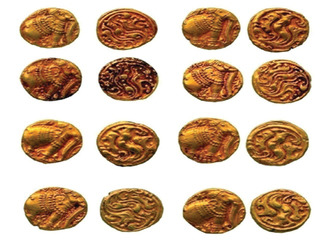 These 13 gold coins dating back to the 7th century are sure to challenge the creativity of the new-age jewellers. The gold coins were found four years ago at a temple in Shivamogga district
and were kept at the Archaeological Survey of India’s (ASI) Bengaluru office for research. The gold coins, each weighing eight grams and featuring intricate carvings of elephants, were deciphered by
the ASI’s Bengaluru chapter recently.
These 13 gold coins dating back to the 7th century are sure to challenge the creativity of the new-age jewellers. The gold coins were found four years ago at a temple in Shivamogga district
and were kept at the Archaeological Survey of India’s (ASI) Bengaluru office for research. The gold coins, each weighing eight grams and featuring intricate carvings of elephants, were deciphered by
the ASI’s Bengaluru chapter recently.
The archaeologists have concluded that these gold coins go back to the early Ganga period and are one of the rarest finds in recent years. What makes these coins special is the fact that they have inscriptions with names of the rulers.
Bengaluru has a strong connection with the Ganga dynasty. Numerous stone inscriptions and ‘hero stones’ found in and around the city throw up interesting historical facts about the hamlets and rulers during the Ganga period.
Coins of Ganga rulers are rare and whatever we have found so far are coins of later Ganga rulers, that is, after 8th century. These 13 coins are of early Ganga period which is between fifth and seventh century. The ‘aane varaa (coins bearing elephant carvings) are spectacular,” says TM Keshava, the then deputy superintending archaeologist who had led the excavation with the technical team of Archaeological Survey of India, Bengaluru Circle.
To read the complete article, see:
(http://bangaloremirror.indiatimes.com/bangalore/others/gold-coins-from-7th-century-deciphered/articleshow/62610470.cms)
THE ART OF OBSOLETE SEPTA TOKENS
On Monday, SEPTA stopped selling tokens at station machines and cashier booths.
SEPTA is the last major transit agency in the United States to still use tokens.
It’s a big step forward in moving riders onto the new fare card system, SEPTA Key, which has advanced in stops and starts. If SEPTA hits its new deadline of fully implementing Key by 2019, the authority will complete the project five years after the original due date.
But despite grousing for years over the long-delayed fare system upgrade, riders are now starting to feel nostalgic for the coins they used to curse.
It’s like being at a funeral for a jerk that died unexpectedly. One minute, nobody can stand the guy. The next, everyone’s sharing what they’ll miss about him.
SEPTA’s tokens were hard to find and easy to lose, and a source of constant, provincial embarrassment whenever a visitor asked: “Wait, you guys still use tokens?”
And yet, instead of dancing on their mass grave as SEPTA pulls the plug, Philadelphians are suddenly full of fond remembrances of the infernal silver- and copper- colored coins.
The token’s imminent demise has spawned a mini-industry of token-based arts and crafts.
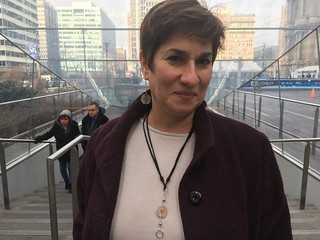 Anita Mastroieni runs Tokens of Affection along with two of her oldest friends. The trio of Hallahan High grads turn SEPTA Tokens into earrings and necklaces, which they name after
different stops. At the trade-shows where they sell them, people come up demanding the station they used as kids.
Anita Mastroieni runs Tokens of Affection along with two of her oldest friends. The trio of Hallahan High grads turn SEPTA Tokens into earrings and necklaces, which they name after
different stops. At the trade-shows where they sell them, people come up demanding the station they used as kids.
“It’s funny to us because we just randomly assign the names, we don’t really mean anything on that set of earrings, but people want their Tioga earrings, they want their Margaret Orthodox earrings because that's what they associate with,” she says. “That's their stop, and that's really meaningful to people.”
To read the complete article, see:
The artistry of saying goodbye to tokens
(http://planphilly.com/articles/2018/01/23/septa-tokens-jewelry-arts-sale)

A MEDAL OF MICHELANGELO
Regarding Maureen and Stu Levine's article last week, Steve Roach writes:
The Michelangelo exhibit at the Metropolitan Museum included a medal depicting the artist as well!
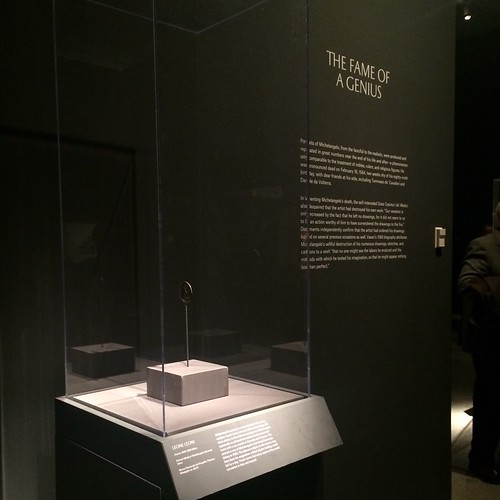
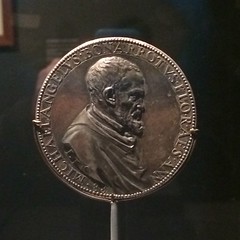
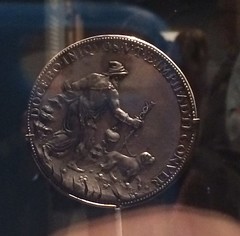
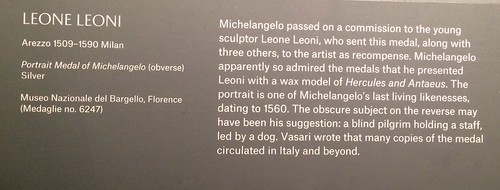
To read the earlier E-Sylum article, see:
MICHELANGELO, BEATRIZET, AND THOMAS CORAM (http://www.coinbooks.org/v21/esylum_v21n03a16.html)

SOVIET ERA RUSSIAN ZNACHKI

I always took the word ?????? to basically mean little badge or pins. Znachki is the diminutive form of the word ????/znak or badge/insignia. The Russian mint is run by Goznak (??????????????? ???? or State Insignia), and they also manufacture orders and decorations, print currency, and other security related items. Znachki were collected avidly and you could get little folders full of a specific theme. I don't know if any guide books were ever written on them per se, though I would imagine so.
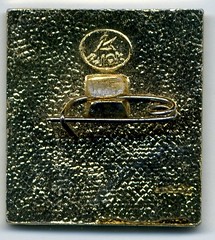 Here are some Soviet era znachki, mostly with Lenin themes, that I actually got in Russia in January 1992. The Lenin ones are from the mid to late 1980s as are the other ones on the card
labelled "Wars of Russia." The pin in the middle of the bottom row of the Lenin-themed znachki can be dated to early 1986. That piece commemorates the 27th Congress of the Communist Party
of the Soviet Union (XXVII ????? ????), notable as being the first party congress presided over by Mikhail Gorbachev, where he set the stage for perestroika. The reverse of most znachki all bear a
maker's mark as well as the price - the example illustrated is the back of the 27th Party Congress pin, ?10k ("???? 10 ??????" / "price 10 kopecks").
Here are some Soviet era znachki, mostly with Lenin themes, that I actually got in Russia in January 1992. The Lenin ones are from the mid to late 1980s as are the other ones on the card
labelled "Wars of Russia." The pin in the middle of the bottom row of the Lenin-themed znachki can be dated to early 1986. That piece commemorates the 27th Congress of the Communist Party
of the Soviet Union (XXVII ????? ????), notable as being the first party congress presided over by Mikhail Gorbachev, where he set the stage for perestroika. The reverse of most znachki all bear a
maker's mark as well as the price - the example illustrated is the back of the 27th Party Congress pin, ?10k ("???? 10 ??????" / "price 10 kopecks").
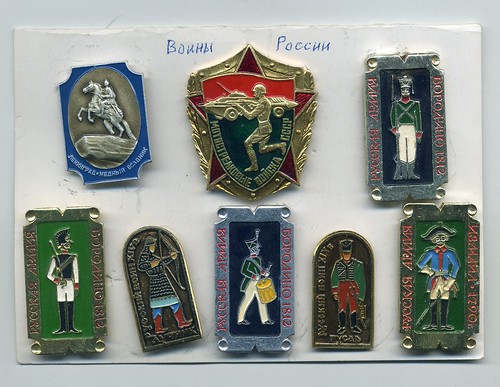
PINK GOLD BREAST CANCER AWARENESS $5 COIN
I also came up empty looking for images of the actual coin on the Mint web site. But here is an image from the U.S. Mint as seen on the Coin World article. Follow the link to read the full article online. I learned that Paul made a special arrangement with the Mint to get the images, which are used here with permission. Great work! -Editor
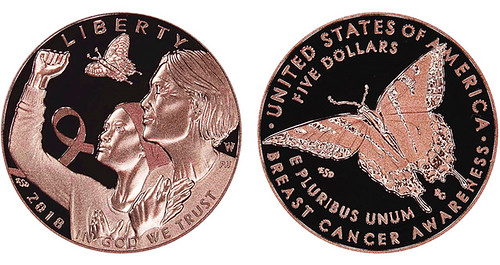
Images by U.S. Mint courtesy of Coin World
To read the Coin World article, see:
U.S. Mint introduces its first pink gold coin with Breast Cancer Awareness $5 half
eagle (https://www.coinworld.com/news/us-coins/2018/01/us-mint-strikes-first-pink-gold-commemorative-coin.html)
To read the Maloney version, see:
U.S. Mint introduces its first pink gold coin with Breast
Cancer Awareness $5 half eagle (https://maloney.house.gov/media-center/in-the-news/us-mint-introduces-its-first-pink-gold-coin-with-breast-cancer-awareness-5)

DENNIS TUCKER ON THE NEW U.S. MINT MEDAL PROGRAMS
Medal collectors—you’re in for some treats! As a longtime collector and student of medallic art, I’m excited about two new programs announced in today’s meeting (Tuesday, January 16, 2018) of the Citizens Coinage Advisory Committee (CCAC). Ann Bailey, the Mint’s program manager for numismatics and bullion, discussed a new series of silver Presidential medals and an upcoming program of military-service medals.
Historical Presidential Medals in .999 Fine Silver
The silver Presidential medals will be similar to recent issues (reissues, really, because they use historical Mint medal designs) in various “Coin and Chronicles” sets, but
the program will include all Presidential medals, and they’ll be minted in Proof, rather than regular-strike format. The Mint will strike these medals on standard American Silver Eagle planchets (.999 fine, measuring 40.6 mm, slightly larger than a silver dollar), starting with two medals in 2018 and then issuing four more per year until completion.
They’ll be sold as what used to be called “list” medals (national medals published in the Mint’s annual product list)—on sale in perpetuity, as permanent items in the Mint catalog, with no ordering limits, time windows, or other such restrictions.
U.S. Military Service Medals in .999 Fine Silver
Another new program currently in the works will include .999 fine silver medals for the U.S. Army, Navy, Marines, Air Force, and Coast Guard, with the possibility of including the National Guard (Army and/or Air Force). These medals will focus on celebrating the military branches themselves, as opposed to particular wars, battles, or anniversaries. (Good news for the U.S. Air Force, for example, which won’t celebrate its centennial—and therefore probably won’t see an official legal-tender commemorative coin—until the year 2047.)
As with the planned Presidential medals, these will be minted on standard American Silver Eagle planchets, 40.6 mm in diameter and composed of .999 pure silver. They’ll be issued without dates and without mintmarks. Like the silver Presidential medals, they’ll become part of the Mint’s “list”—permanently featured in its catalog, issued in perpetuity, with no ordering limits. Everyone who wants one will be able to get one, directly from the United States Mint, without paying a markup to an aftermarket distributor.
This upcoming new medal program will give collectors an opportunity to acquire outstanding classic American artwork by some of the Mint’s most talented engravers. The fact that they’ll be minted in pure silver, and in Proof format, practically guarantees the program’s success. Watch for the inevitable best-sellers: the Mount Rushmore presidents (Washington, Jefferson, Lincoln, and T. Roosevelt) and Franklin D. Roosevelt, with more recent chief executives such as Truman, Eisenhower, Kennedy, Reagan, both Bushes, Clinton, Obama, and others undoubtedly appealing to many fans.
If you’re a medal collector, I hope you’re as excited and pleased as I am with the United States Mint and its recent innovations in this field of our hobby. The Mint is showing long-term commitment to interesting and popularly themed medal programs, some using classic designs from among our nation’s archives, and others stepping into modern territory with the work of living artists. Kudos to the Mint. We await your work!
To read the complete article, see:
Medal collectors: A treasure chest of new silver issues is coming
from the United States Mint (http://news.coinupdate.com/medal-collectors-a-treasure-chest-of-new-silver-issues-is-coming-from-the-united-states-mint/)
SCARINCI ON THE U.S. MINT'S NEW MEDAL PROGRAM
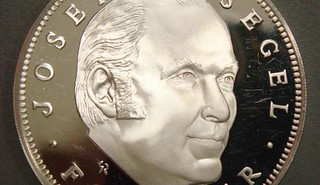 Last week, after years of prodding by members of the Citizens Coinage Advisory Committee (CCAC) and the collector community, the United States Mint finally announced a medal program.
Unfortunately, it is nothing more than a bullion sales program and is likely to do more to discourage future medal collectors than to encourage them.
Last week, after years of prodding by members of the Citizens Coinage Advisory Committee (CCAC) and the collector community, the United States Mint finally announced a medal program.
Unfortunately, it is nothing more than a bullion sales program and is likely to do more to discourage future medal collectors than to encourage them.
The current plan is to reissue the bronze presidential medal series on proof silver eagle dollar size planchets. Then, the plan is to eventually honor each branch of the armed services with similar proof silver eagle dollar size medals. That’s the plan: more restrike medals and more military themes from the United States Mint.
While the Mint marketing team may have heard the CCAC’s plea for a medal program, they did not listen. The CCAC has been advocating an annual art medal program that is more like those offered by many other world mints.
Liberate and Stimulate Artists to Create Better Coin Designs
A competition for a United States Mint medal, unencumbered by the directions and design restrictions that are usually placed on coins, would liberate and stimulate artistic excellence. Great artists have to labor through boring instructions for coin designs, only to listen to CCAC members complain about the designs.
A medal program would unleash new, contemporary designs. The artists would have the freedom to display their talent and create hand-held works of art that inspire and evoke emotion. They would most certainly win much needed recognition for themselves and for the Mint. A medal program like this would then have a positive impact on the work that Congress asks these same artists to do with coins.
Medals should not be bullion products. The truth is that the U.S. Mint’s marketing team cannot project art medal sales. They can project bullion sales. So they went with what they know. The Mint’s marketing department completely understands the precious metals market, but they have no idea what collectors want or how collectors think. To expect them to design a program to encourage collectors and create a new market is far beyond their comfort zone.
Remember the Lesson of the Franklin Mint of the 1960’s
The MBA’s need look no further than the case study of the Franklin Mint. Private minting facilities seldom offer bullion products directly to the retail collecting community. Instead, they make products in volume for retailers who take the risk. Since the United States Mint is both a minting facility and a direct retail outlet with a large customer base, they likely will increase profits in the short term without concern for the damage in the long term. Unlike the business risk for private mints, the United States Mint has a superseding national interest.
The medal collecting specialty never recovered from Joel Siegel’s Franklin Mint marketing efforts. The stigma on medals that he caused still exists. The only good thing he did in addition to making short term profits for himself was to provide a training ground for sculptors to learn and grow. Don Everhart is an example of that. Don will tell you that he learned his craft at the Franklin Mint. Many other great artists who made those Franklin Mint medals would say the same thing.
It needs to be said that Franklin Mint medals will eventually have their comeback. However, their comeback will not be bullion-based. It will be numismatic.
To read the complete article, see:
Newly-Announced US Mint Medal Program is Just Bullion
(http://donaldscarinci.com/newly-announced-us-mint-medal-program-is-just-bullion/)
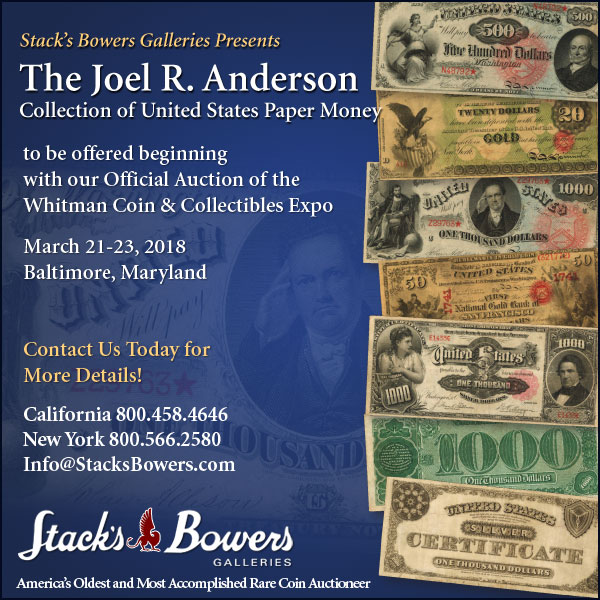
BANKNOTE DESIGN AT NORGES BANK

When Norges Bank started drafting plans for a new banknote series back in 2012, no-one could have predicted governor Øystein Olsen would appear in a cameo role alongside three men dressed in yellow raincoats holding fish in a promotional music video. But it perhaps should not have come as a surprise, since staff at the Norwegian central bank also adopted a philosophy to break many design principles as they set about introducing a new series of banknotes.
While Norway does not have – and never has had – a systemic counterfeit problem, its previous series of notes was beginning to show signs of age, in terms of security. “Our counterfeiting numbers were low, but our neighbouring countries were renewing their banknotes to increase security, and we had to follow suit,” says Trond Eklund, director of Norges Bank’s cashier’s department. “Confidence is the cornerstone of the monetary system and we need the public to be confident in our banknotes.”
The banknote department decided upon the theme of ‘the sea’ relatively quickly. “The ocean has always [shaped] – and will continue to shape – the identity of our nation, and so it was a natural choice for us,” says Eklund. Five banknotes were to be printed, so five subthemes were created to aid the design process of juxtaposing how the sea has brought economic prosperity to the Nordic nation.
Banknote designs tend to be based on simple pictures. Some, such as Swiss banknotes, are drawn using computer-aided design tools. Norges Bank, on the other hand, has a tradition of converting designs freehand into line drawings. For the Nkr100 note, one of the two banknotes to be released into circulation in 2017, former Norges Bank banknote designer Sverre Morken was brought in to convert Metric’s longboat design. “Banknotes are a form of graphic art,” says Morken. “I spent around 160 hours drawing the design.”
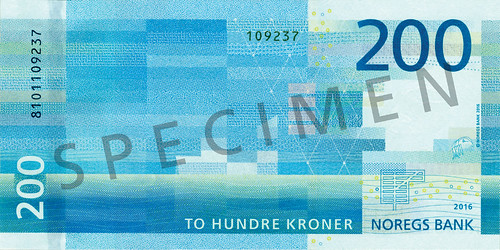
But while the fronts of the notes are steeped in tradition, the reverse sides of the notes tell a very different tale. “When we were deciding what the back of the banknotes would look like, we decided not to use Metric’s proposed design. Instead, we used the proposed fronts from [architecture studio] Snøhetta. In this way, we formed a combination of traditional and modern expression,” says Eklund. Through experimentation with other submissions, Snøhetta’s stood out as a clear winner.
Enhanced security features have been integrated into the maritime designs. Metallic and colour-changing holograms have been used to the form of anchor chains and rings symbolising ripples in the water. Meanwhile, puffins appear as watermarks and small images only visible under ultraviolet light. The central bank has also integrated a security thread, micro-lettering, iridescent elements into the banknotes.
To read the complete article, see:
Banknote and currency manager of the year: Norges Bank
(https://www.centralbanking.com/awards/3343326/banknote-and-currency-manager-of-the-year-norges-bank)
RENOVATION UNCOVERS DECADES-OLD COIN COLLECTION
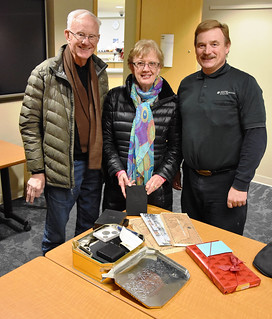 A collection of coins stored in a ceiling for safe keeping in the 1990s was discovered during a recent renovation and returned to their rightful owners years after they moved out of their
Maple Ridge, B.C. residence.
A collection of coins stored in a ceiling for safe keeping in the 1990s was discovered during a recent renovation and returned to their rightful owners years after they moved out of their
Maple Ridge, B.C. residence.
City carpenter Mark Christiansen was finishing renovations on the city-owned earlier in 2017 when he made the discovery, which also include a century-old First World War pin.
“I was replacing some old paneling on the basement ceiling when I noticed a rattling sound,” said Christiansen. “I pulled the paneling off carefully and lifted out an old gold cookie tin that was sealed with duct tape from above the ceiling. The tin was quite heavy and when I removed the tape and opened the lid I discovered a large collection of coins.”
“We were so excited when we got the call from Darrell. Alf put the coins up in the ceiling in the 1990s for safe keeping,” said Sharon Mintha, who added the names were indeed the names of their son and daughter.
“Those coins were gifts from my father, their grandfather. The kids were young so we put the coins away for them.”
“We came home from meeting you all, and sat at the kitchen table for the longest time just looking at everything. We found something that is very dear to me. It is a pin given to my grandfather by the Canadian Government. It says ‘For Service at the Front.’ He was at Vimy Ridge during all the action.”
To read the complete article, see:
Decades-old coin collection discovered during renovation of B.C. home
(https://canadiancoinnews.com/coin-collection-discovered-renovation-b-c-home/)
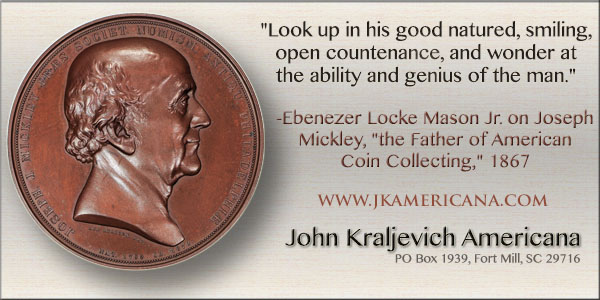
TIME-LAPSE VIDEO: SHREDDED BANKNOTE RECONSTRUCTION
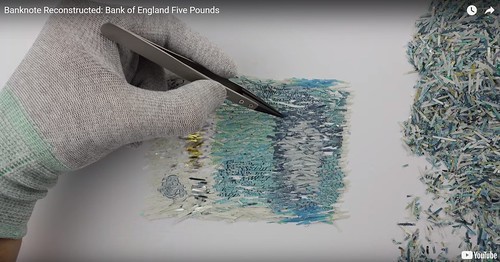
Conceptual artist Martin John Callanan has a thing for puzzles. He spent one whole day working on a five-pound misprinted note that was destroyed by the Bank of England. The objective? Put it back together.
His incredible 11-minute time-lapse video demonstrates his remarkable patience and determination as he slowly worked on the shredded currency note. First, though, he had to get in touch with the Bank of England to get hold of out-of-circulation shredded cash.
He used tweezers to work slowly, reassembling the pieces painstakingly. The final result, of course, only loosely resembles the original note, but it’s worth noting that he did succeed in getting all the bits and pieces in the right places.
To read the complete article, see:
Watch: This incredibly patient man reconstructed a shredded banknote. But is
it art? (https://scroll.in/video/865367/watch-this-incredibly-patient-man-reconstructed-a-shredded-banknote-but-is-it-art)
HACKER JACKPOTS: ATMS SPIT OUT THEIR BANKNOTES
Hackers able to make ATMs spit cash like winning slot machines are now operating inside the United States, marking the arrival of “jackpotting” attacks after widespread heists in Europe and Asia, according to the world’s largest ATM makers and security news website, Krebs on Security.
Thieves have used skimming devices on ATM machines to steal debit card information, but “jackpotting” augurs more sophisticated technological challenges that American financial firms will face in coming years.
“This is the first instance of jackpotting in the United States,” said digital security reporter Brian Krebs, a former Washington Post reporter. “It’s safe to assume that these are here to stay at this point.”
Krebs reported that criminal gangs are targeting Diebold Nixdorf ATM machines — the stand-alone kind you might see in a drive-through or pharmacy. He shared the ATM giant’s security notice. It described similar attacks in Mexico, in which criminals used a modified medical endoscope to access a port inside the machines and install malware.
Hackers have also been reported to remotely infect ATMs or completely swap out their hard drives. The Secret Service could not be immediately reached for comment about the nature of the reported U.S. attacks.
Whichever method is used, the results are about the same. At a hacker conference in 2010, Wired reported, a researcher brought two infected ATMs to the stage and gave a demonstration.
In the first example, a volunteer from the audience swiped a card through the ATM, and the researcher instantly brought up his credit card number and personal information on a computer spreadsheet.
In the second, the researcher gave the machine a command. “Jackpot!!” flashed on the ATM’s screen, and it began spitting bills onto the floor as the crowd cheered.
To read the complete article, see:
Hackers are making U.S. ATMs spit out cash like slot
machines (https://www.washingtonpost.com/news/business/wp/2018/01/27/hackers-are-making-u-s-atms-spit-out-cash-like-slot-machines-report-warns/)

FEATURED WEB SITE: OCALA COIN CLUB
This week's Featured Web Site is the Ocala Coin Club of Florida, the home club of John and Nancy Wilson, who write:We recently went to our Ocala Coin Club web site and to our amazement a member of the coin club spent countless hours organizing all types of numismatic web pages, by category. We have never seen such a compilation of different resources for coin, currency, paper money, tokens and medals and or general interest published anywhere.
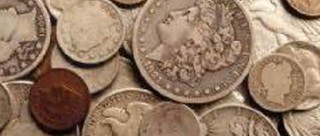
www.ocalacoinclub.com

